Managing Change at Ooredoo Telecommunication
VerifiedAdded on 2022/08/13
|23
|6539
|33
AI Summary
Contribute Materials
Your contribution can guide someone’s learning journey. Share your
documents today.
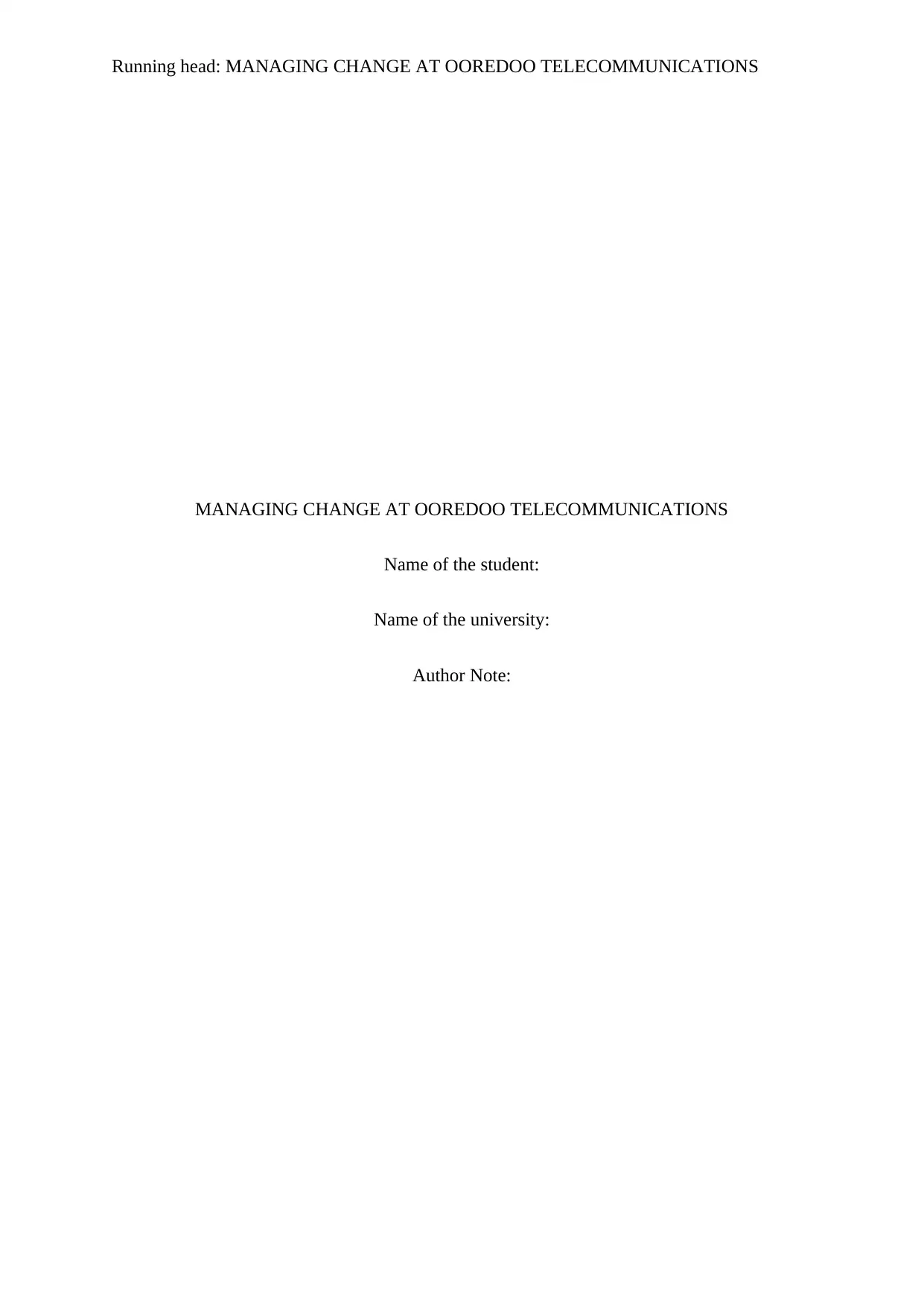
Running head: MANAGING CHANGE AT OOREDOO TELECOMMUNICATIONS
MANAGING CHANGE AT OOREDOO TELECOMMUNICATIONS
Name of the student:
Name of the university:
Author Note:
MANAGING CHANGE AT OOREDOO TELECOMMUNICATIONS
Name of the student:
Name of the university:
Author Note:
Secure Best Marks with AI Grader
Need help grading? Try our AI Grader for instant feedback on your assignments.
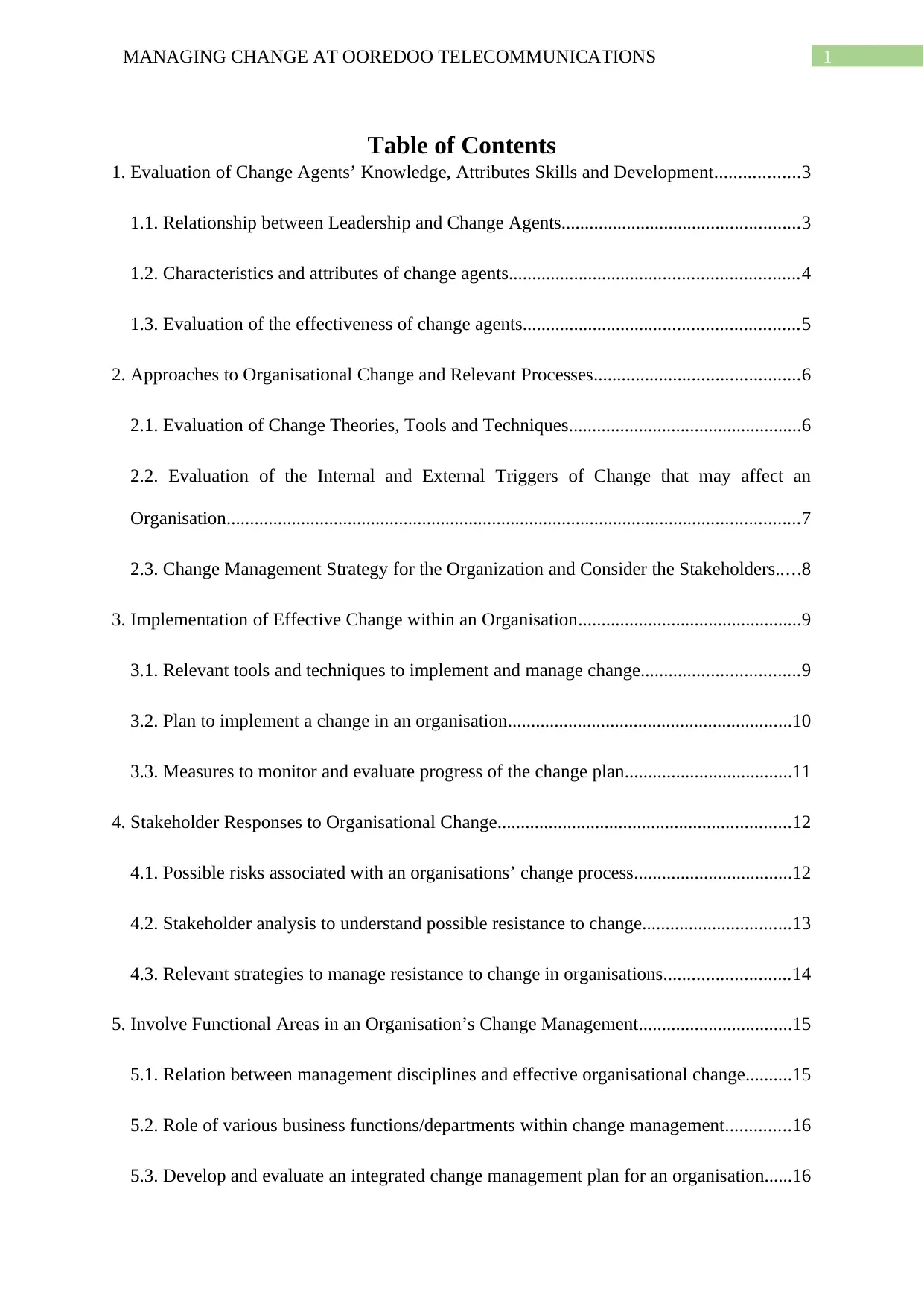
1MANAGING CHANGE AT OOREDOO TELECOMMUNICATIONS
Table of Contents
1. Evaluation of Change Agents’ Knowledge, Attributes Skills and Development..................3
1.1. Relationship between Leadership and Change Agents...................................................3
1.2. Characteristics and attributes of change agents..............................................................4
1.3. Evaluation of the effectiveness of change agents...........................................................5
2. Approaches to Organisational Change and Relevant Processes............................................6
2.1. Evaluation of Change Theories, Tools and Techniques..................................................6
2.2. Evaluation of the Internal and External Triggers of Change that may affect an
Organisation...........................................................................................................................7
2.3. Change Management Strategy for the Organization and Consider the Stakeholders.....8
3. Implementation of Effective Change within an Organisation................................................9
3.1. Relevant tools and techniques to implement and manage change..................................9
3.2. Plan to implement a change in an organisation.............................................................10
3.3. Measures to monitor and evaluate progress of the change plan....................................11
4. Stakeholder Responses to Organisational Change...............................................................12
4.1. Possible risks associated with an organisations’ change process..................................12
4.2. Stakeholder analysis to understand possible resistance to change................................13
4.3. Relevant strategies to manage resistance to change in organisations...........................14
5. Involve Functional Areas in an Organisation’s Change Management.................................15
5.1. Relation between management disciplines and effective organisational change..........15
5.2. Role of various business functions/departments within change management..............16
5.3. Develop and evaluate an integrated change management plan for an organisation......16
Table of Contents
1. Evaluation of Change Agents’ Knowledge, Attributes Skills and Development..................3
1.1. Relationship between Leadership and Change Agents...................................................3
1.2. Characteristics and attributes of change agents..............................................................4
1.3. Evaluation of the effectiveness of change agents...........................................................5
2. Approaches to Organisational Change and Relevant Processes............................................6
2.1. Evaluation of Change Theories, Tools and Techniques..................................................6
2.2. Evaluation of the Internal and External Triggers of Change that may affect an
Organisation...........................................................................................................................7
2.3. Change Management Strategy for the Organization and Consider the Stakeholders.....8
3. Implementation of Effective Change within an Organisation................................................9
3.1. Relevant tools and techniques to implement and manage change..................................9
3.2. Plan to implement a change in an organisation.............................................................10
3.3. Measures to monitor and evaluate progress of the change plan....................................11
4. Stakeholder Responses to Organisational Change...............................................................12
4.1. Possible risks associated with an organisations’ change process..................................12
4.2. Stakeholder analysis to understand possible resistance to change................................13
4.3. Relevant strategies to manage resistance to change in organisations...........................14
5. Involve Functional Areas in an Organisation’s Change Management.................................15
5.1. Relation between management disciplines and effective organisational change..........15
5.2. Role of various business functions/departments within change management..............16
5.3. Develop and evaluate an integrated change management plan for an organisation......16
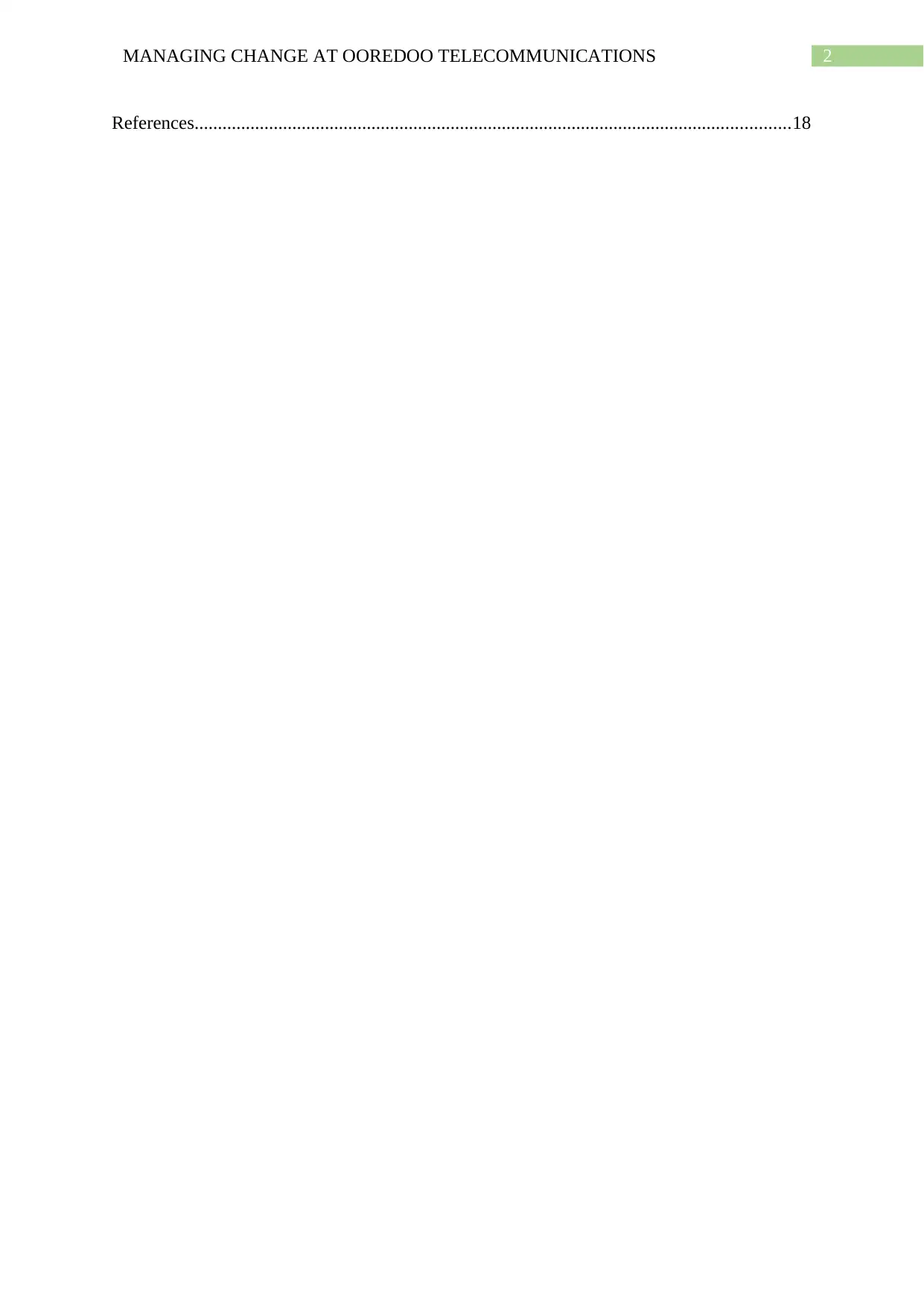
2MANAGING CHANGE AT OOREDOO TELECOMMUNICATIONS
References................................................................................................................................18
References................................................................................................................................18
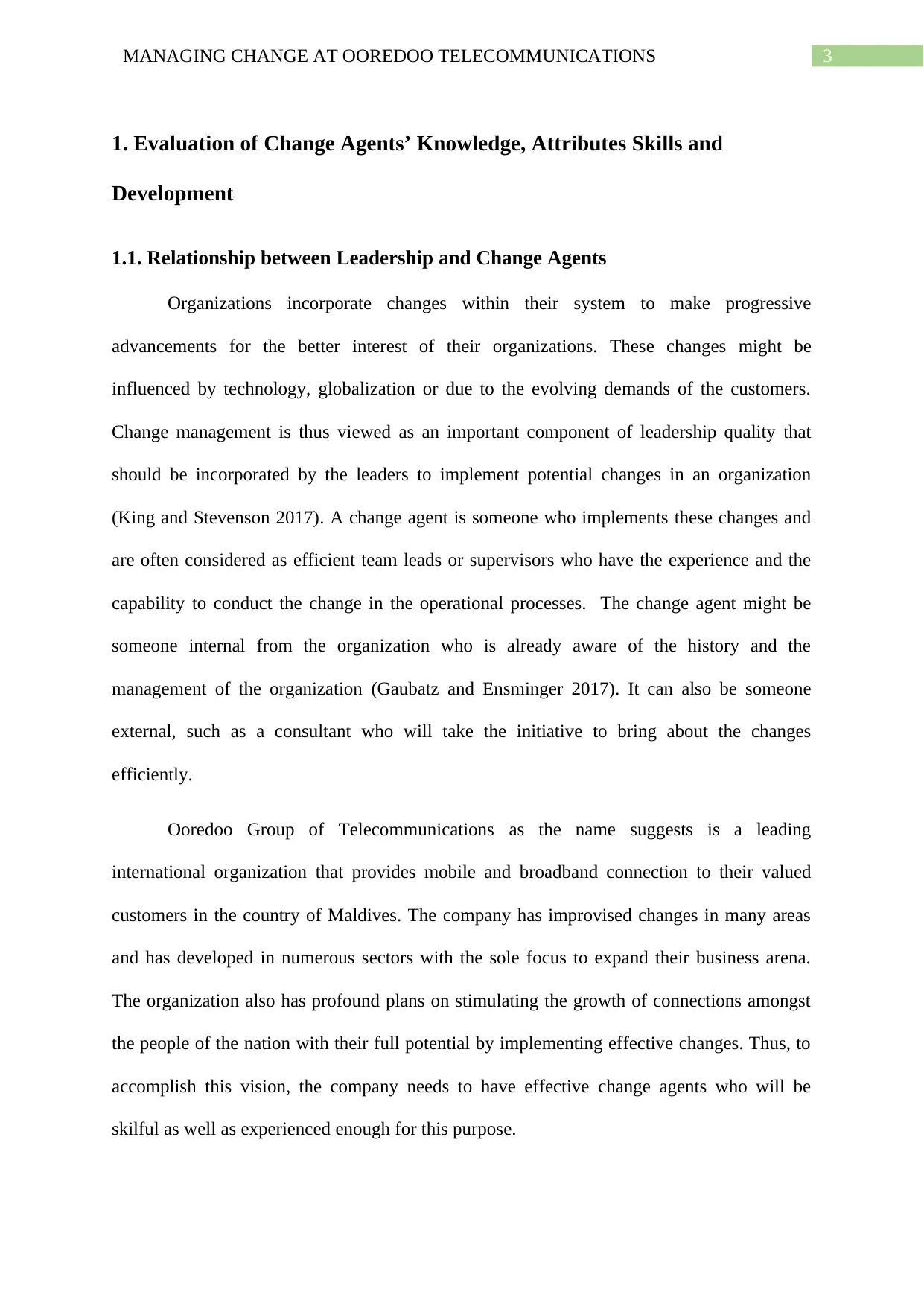
3MANAGING CHANGE AT OOREDOO TELECOMMUNICATIONS
1. Evaluation of Change Agents’ Knowledge, Attributes Skills and
Development
1.1. Relationship between Leadership and Change Agents
Organizations incorporate changes within their system to make progressive
advancements for the better interest of their organizations. These changes might be
influenced by technology, globalization or due to the evolving demands of the customers.
Change management is thus viewed as an important component of leadership quality that
should be incorporated by the leaders to implement potential changes in an organization
(King and Stevenson 2017). A change agent is someone who implements these changes and
are often considered as efficient team leads or supervisors who have the experience and the
capability to conduct the change in the operational processes. The change agent might be
someone internal from the organization who is already aware of the history and the
management of the organization (Gaubatz and Ensminger 2017). It can also be someone
external, such as a consultant who will take the initiative to bring about the changes
efficiently.
Ooredoo Group of Telecommunications as the name suggests is a leading
international organization that provides mobile and broadband connection to their valued
customers in the country of Maldives. The company has improvised changes in many areas
and has developed in numerous sectors with the sole focus to expand their business arena.
The organization also has profound plans on stimulating the growth of connections amongst
the people of the nation with their full potential by implementing effective changes. Thus, to
accomplish this vision, the company needs to have effective change agents who will be
skilful as well as experienced enough for this purpose.
1. Evaluation of Change Agents’ Knowledge, Attributes Skills and
Development
1.1. Relationship between Leadership and Change Agents
Organizations incorporate changes within their system to make progressive
advancements for the better interest of their organizations. These changes might be
influenced by technology, globalization or due to the evolving demands of the customers.
Change management is thus viewed as an important component of leadership quality that
should be incorporated by the leaders to implement potential changes in an organization
(King and Stevenson 2017). A change agent is someone who implements these changes and
are often considered as efficient team leads or supervisors who have the experience and the
capability to conduct the change in the operational processes. The change agent might be
someone internal from the organization who is already aware of the history and the
management of the organization (Gaubatz and Ensminger 2017). It can also be someone
external, such as a consultant who will take the initiative to bring about the changes
efficiently.
Ooredoo Group of Telecommunications as the name suggests is a leading
international organization that provides mobile and broadband connection to their valued
customers in the country of Maldives. The company has improvised changes in many areas
and has developed in numerous sectors with the sole focus to expand their business arena.
The organization also has profound plans on stimulating the growth of connections amongst
the people of the nation with their full potential by implementing effective changes. Thus, to
accomplish this vision, the company needs to have effective change agents who will be
skilful as well as experienced enough for this purpose.
Secure Best Marks with AI Grader
Need help grading? Try our AI Grader for instant feedback on your assignments.
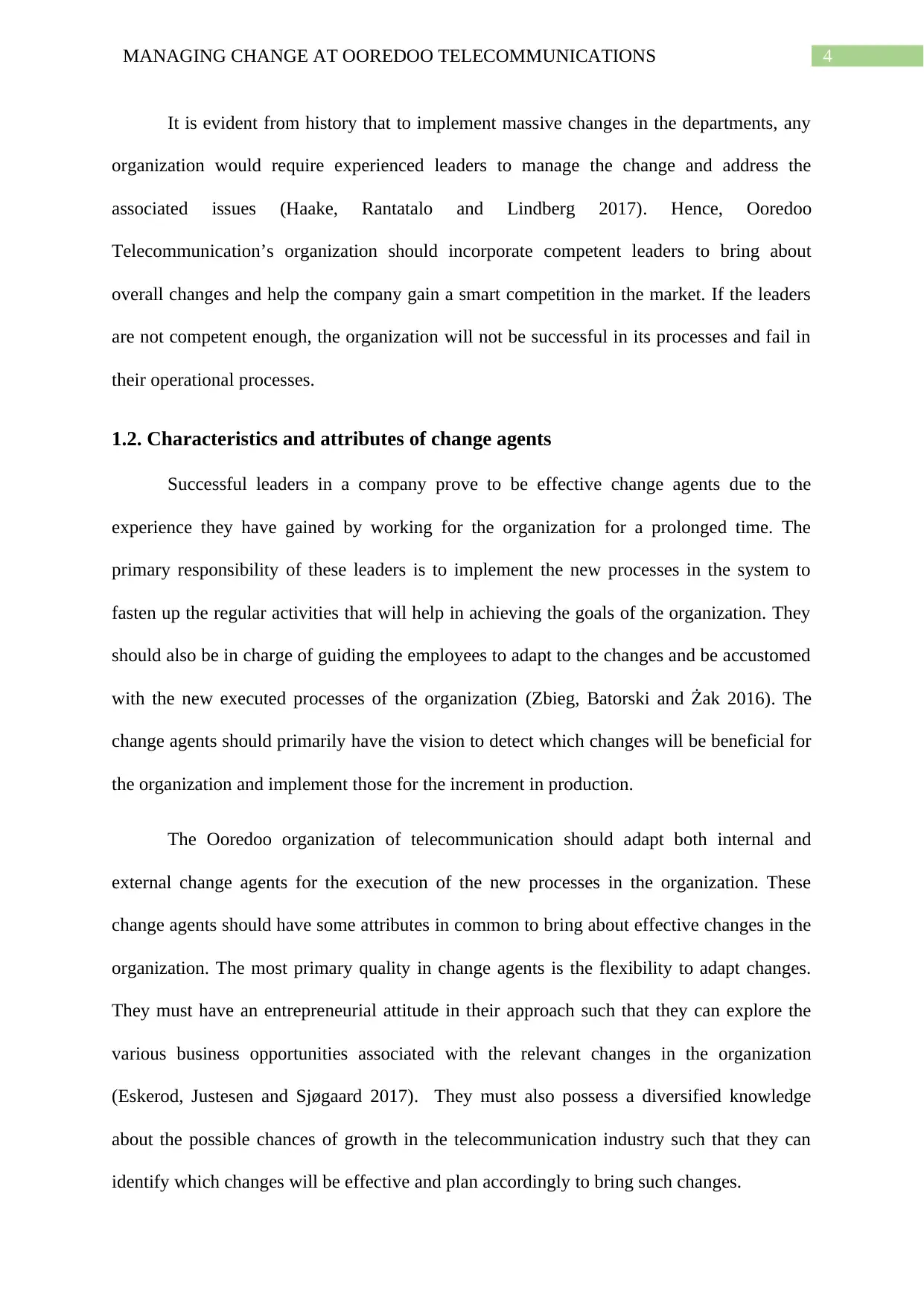
4MANAGING CHANGE AT OOREDOO TELECOMMUNICATIONS
It is evident from history that to implement massive changes in the departments, any
organization would require experienced leaders to manage the change and address the
associated issues (Haake, Rantatalo and Lindberg 2017). Hence, Ooredoo
Telecommunication’s organization should incorporate competent leaders to bring about
overall changes and help the company gain a smart competition in the market. If the leaders
are not competent enough, the organization will not be successful in its processes and fail in
their operational processes.
1.2. Characteristics and attributes of change agents
Successful leaders in a company prove to be effective change agents due to the
experience they have gained by working for the organization for a prolonged time. The
primary responsibility of these leaders is to implement the new processes in the system to
fasten up the regular activities that will help in achieving the goals of the organization. They
should also be in charge of guiding the employees to adapt to the changes and be accustomed
with the new executed processes of the organization (Zbieg, Batorski and Żak 2016). The
change agents should primarily have the vision to detect which changes will be beneficial for
the organization and implement those for the increment in production.
The Ooredoo organization of telecommunication should adapt both internal and
external change agents for the execution of the new processes in the organization. These
change agents should have some attributes in common to bring about effective changes in the
organization. The most primary quality in change agents is the flexibility to adapt changes.
They must have an entrepreneurial attitude in their approach such that they can explore the
various business opportunities associated with the relevant changes in the organization
(Eskerod, Justesen and Sjøgaard 2017). They must also possess a diversified knowledge
about the possible chances of growth in the telecommunication industry such that they can
identify which changes will be effective and plan accordingly to bring such changes.
It is evident from history that to implement massive changes in the departments, any
organization would require experienced leaders to manage the change and address the
associated issues (Haake, Rantatalo and Lindberg 2017). Hence, Ooredoo
Telecommunication’s organization should incorporate competent leaders to bring about
overall changes and help the company gain a smart competition in the market. If the leaders
are not competent enough, the organization will not be successful in its processes and fail in
their operational processes.
1.2. Characteristics and attributes of change agents
Successful leaders in a company prove to be effective change agents due to the
experience they have gained by working for the organization for a prolonged time. The
primary responsibility of these leaders is to implement the new processes in the system to
fasten up the regular activities that will help in achieving the goals of the organization. They
should also be in charge of guiding the employees to adapt to the changes and be accustomed
with the new executed processes of the organization (Zbieg, Batorski and Żak 2016). The
change agents should primarily have the vision to detect which changes will be beneficial for
the organization and implement those for the increment in production.
The Ooredoo organization of telecommunication should adapt both internal and
external change agents for the execution of the new processes in the organization. These
change agents should have some attributes in common to bring about effective changes in the
organization. The most primary quality in change agents is the flexibility to adapt changes.
They must have an entrepreneurial attitude in their approach such that they can explore the
various business opportunities associated with the relevant changes in the organization
(Eskerod, Justesen and Sjøgaard 2017). They must also possess a diversified knowledge
about the possible chances of growth in the telecommunication industry such that they can
identify which changes will be effective and plan accordingly to bring such changes.
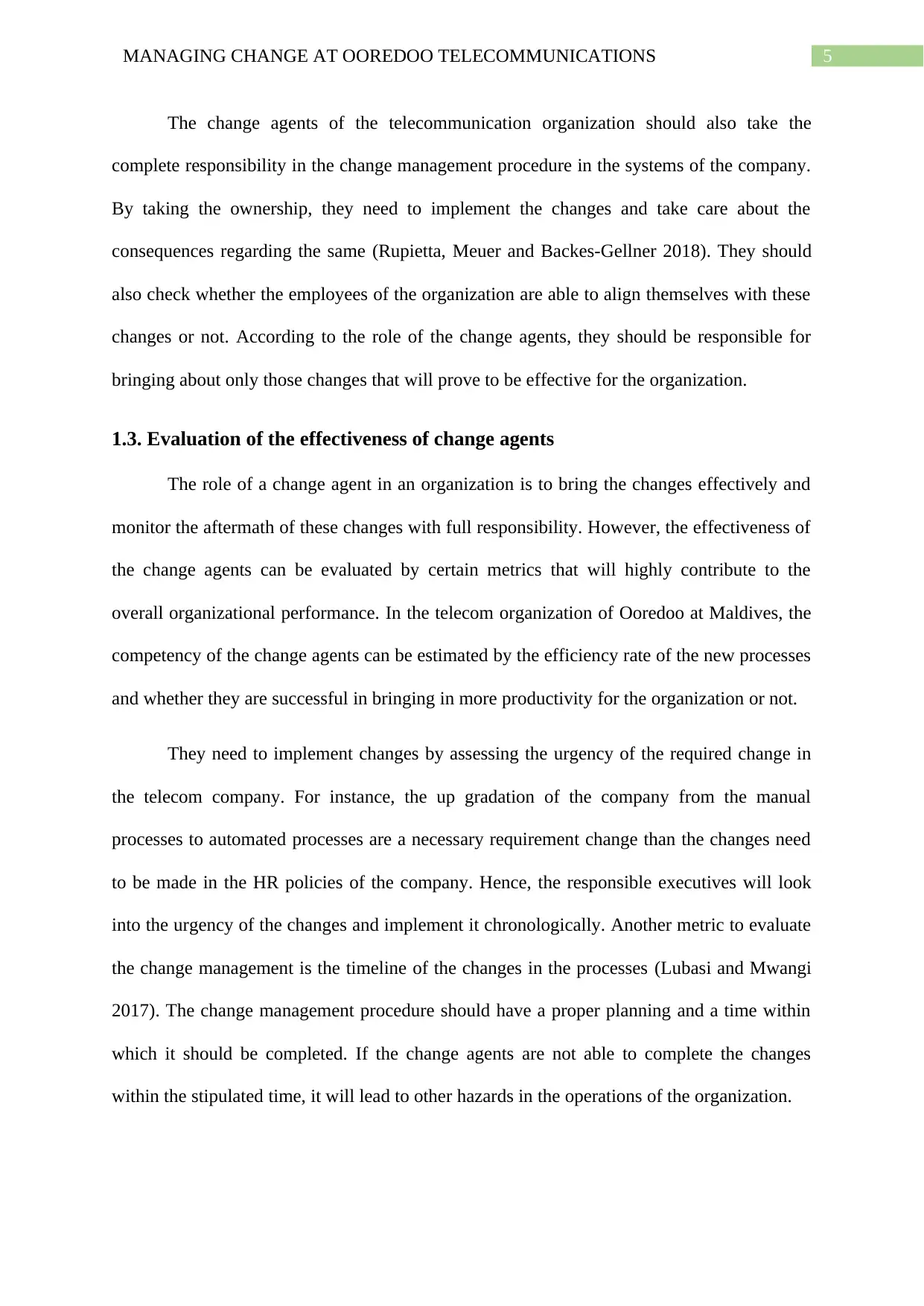
5MANAGING CHANGE AT OOREDOO TELECOMMUNICATIONS
The change agents of the telecommunication organization should also take the
complete responsibility in the change management procedure in the systems of the company.
By taking the ownership, they need to implement the changes and take care about the
consequences regarding the same (Rupietta, Meuer and Backes-Gellner 2018). They should
also check whether the employees of the organization are able to align themselves with these
changes or not. According to the role of the change agents, they should be responsible for
bringing about only those changes that will prove to be effective for the organization.
1.3. Evaluation of the effectiveness of change agents
The role of a change agent in an organization is to bring the changes effectively and
monitor the aftermath of these changes with full responsibility. However, the effectiveness of
the change agents can be evaluated by certain metrics that will highly contribute to the
overall organizational performance. In the telecom organization of Ooredoo at Maldives, the
competency of the change agents can be estimated by the efficiency rate of the new processes
and whether they are successful in bringing in more productivity for the organization or not.
They need to implement changes by assessing the urgency of the required change in
the telecom company. For instance, the up gradation of the company from the manual
processes to automated processes are a necessary requirement change than the changes need
to be made in the HR policies of the company. Hence, the responsible executives will look
into the urgency of the changes and implement it chronologically. Another metric to evaluate
the change management is the timeline of the changes in the processes (Lubasi and Mwangi
2017). The change management procedure should have a proper planning and a time within
which it should be completed. If the change agents are not able to complete the changes
within the stipulated time, it will lead to other hazards in the operations of the organization.
The change agents of the telecommunication organization should also take the
complete responsibility in the change management procedure in the systems of the company.
By taking the ownership, they need to implement the changes and take care about the
consequences regarding the same (Rupietta, Meuer and Backes-Gellner 2018). They should
also check whether the employees of the organization are able to align themselves with these
changes or not. According to the role of the change agents, they should be responsible for
bringing about only those changes that will prove to be effective for the organization.
1.3. Evaluation of the effectiveness of change agents
The role of a change agent in an organization is to bring the changes effectively and
monitor the aftermath of these changes with full responsibility. However, the effectiveness of
the change agents can be evaluated by certain metrics that will highly contribute to the
overall organizational performance. In the telecom organization of Ooredoo at Maldives, the
competency of the change agents can be estimated by the efficiency rate of the new processes
and whether they are successful in bringing in more productivity for the organization or not.
They need to implement changes by assessing the urgency of the required change in
the telecom company. For instance, the up gradation of the company from the manual
processes to automated processes are a necessary requirement change than the changes need
to be made in the HR policies of the company. Hence, the responsible executives will look
into the urgency of the changes and implement it chronologically. Another metric to evaluate
the change management is the timeline of the changes in the processes (Lubasi and Mwangi
2017). The change management procedure should have a proper planning and a time within
which it should be completed. If the change agents are not able to complete the changes
within the stipulated time, it will lead to other hazards in the operations of the organization.
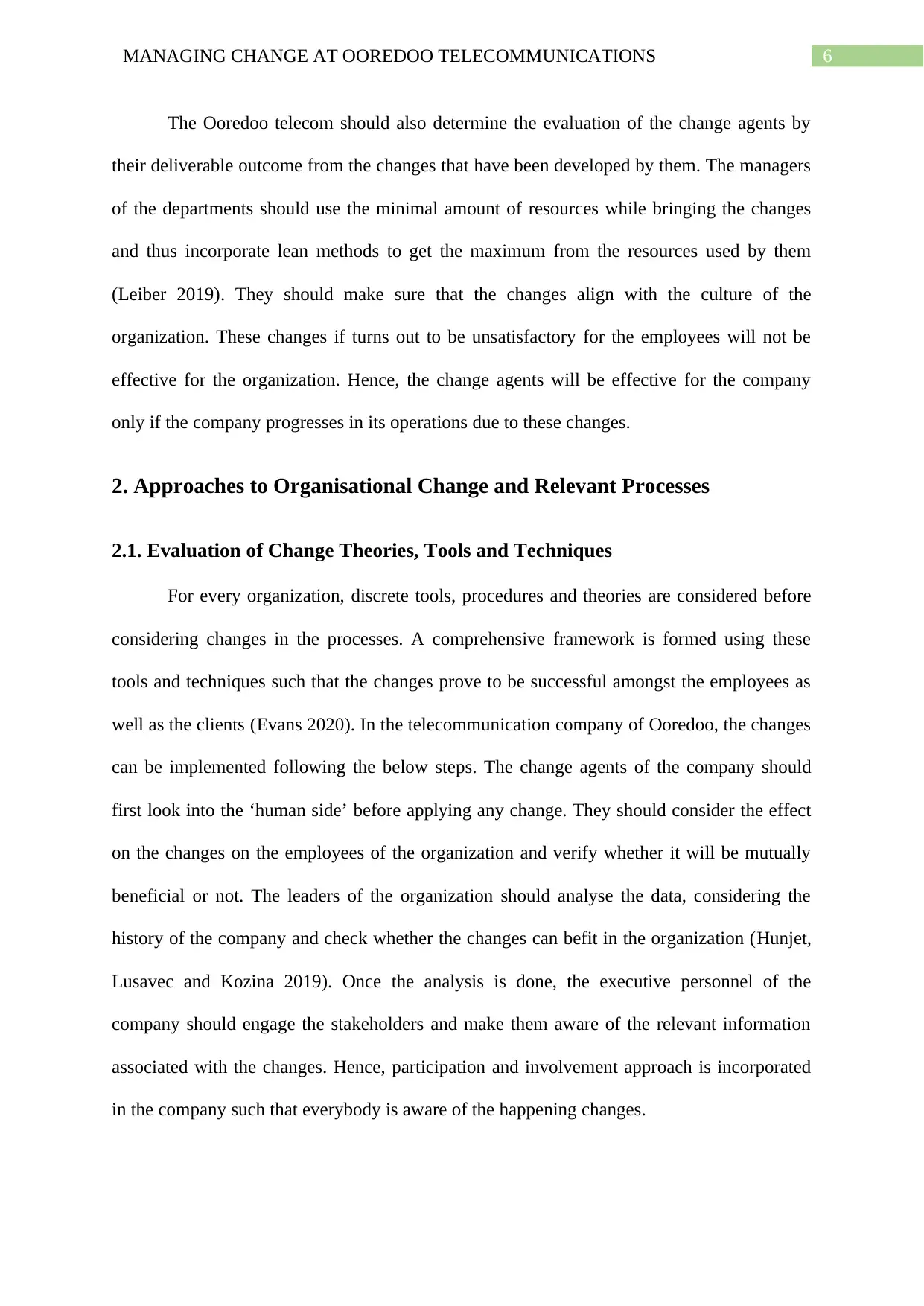
6MANAGING CHANGE AT OOREDOO TELECOMMUNICATIONS
The Ooredoo telecom should also determine the evaluation of the change agents by
their deliverable outcome from the changes that have been developed by them. The managers
of the departments should use the minimal amount of resources while bringing the changes
and thus incorporate lean methods to get the maximum from the resources used by them
(Leiber 2019). They should make sure that the changes align with the culture of the
organization. These changes if turns out to be unsatisfactory for the employees will not be
effective for the organization. Hence, the change agents will be effective for the company
only if the company progresses in its operations due to these changes.
2. Approaches to Organisational Change and Relevant Processes
2.1. Evaluation of Change Theories, Tools and Techniques
For every organization, discrete tools, procedures and theories are considered before
considering changes in the processes. A comprehensive framework is formed using these
tools and techniques such that the changes prove to be successful amongst the employees as
well as the clients (Evans 2020). In the telecommunication company of Ooredoo, the changes
can be implemented following the below steps. The change agents of the company should
first look into the ‘human side’ before applying any change. They should consider the effect
on the changes on the employees of the organization and verify whether it will be mutually
beneficial or not. The leaders of the organization should analyse the data, considering the
history of the company and check whether the changes can befit in the organization (Hunjet,
Lusavec and Kozina 2019). Once the analysis is done, the executive personnel of the
company should engage the stakeholders and make them aware of the relevant information
associated with the changes. Hence, participation and involvement approach is incorporated
in the company such that everybody is aware of the happening changes.
The Ooredoo telecom should also determine the evaluation of the change agents by
their deliverable outcome from the changes that have been developed by them. The managers
of the departments should use the minimal amount of resources while bringing the changes
and thus incorporate lean methods to get the maximum from the resources used by them
(Leiber 2019). They should make sure that the changes align with the culture of the
organization. These changes if turns out to be unsatisfactory for the employees will not be
effective for the organization. Hence, the change agents will be effective for the company
only if the company progresses in its operations due to these changes.
2. Approaches to Organisational Change and Relevant Processes
2.1. Evaluation of Change Theories, Tools and Techniques
For every organization, discrete tools, procedures and theories are considered before
considering changes in the processes. A comprehensive framework is formed using these
tools and techniques such that the changes prove to be successful amongst the employees as
well as the clients (Evans 2020). In the telecommunication company of Ooredoo, the changes
can be implemented following the below steps. The change agents of the company should
first look into the ‘human side’ before applying any change. They should consider the effect
on the changes on the employees of the organization and verify whether it will be mutually
beneficial or not. The leaders of the organization should analyse the data, considering the
history of the company and check whether the changes can befit in the organization (Hunjet,
Lusavec and Kozina 2019). Once the analysis is done, the executive personnel of the
company should engage the stakeholders and make them aware of the relevant information
associated with the changes. Hence, participation and involvement approach is incorporated
in the company such that everybody is aware of the happening changes.
Paraphrase This Document
Need a fresh take? Get an instant paraphrase of this document with our AI Paraphraser
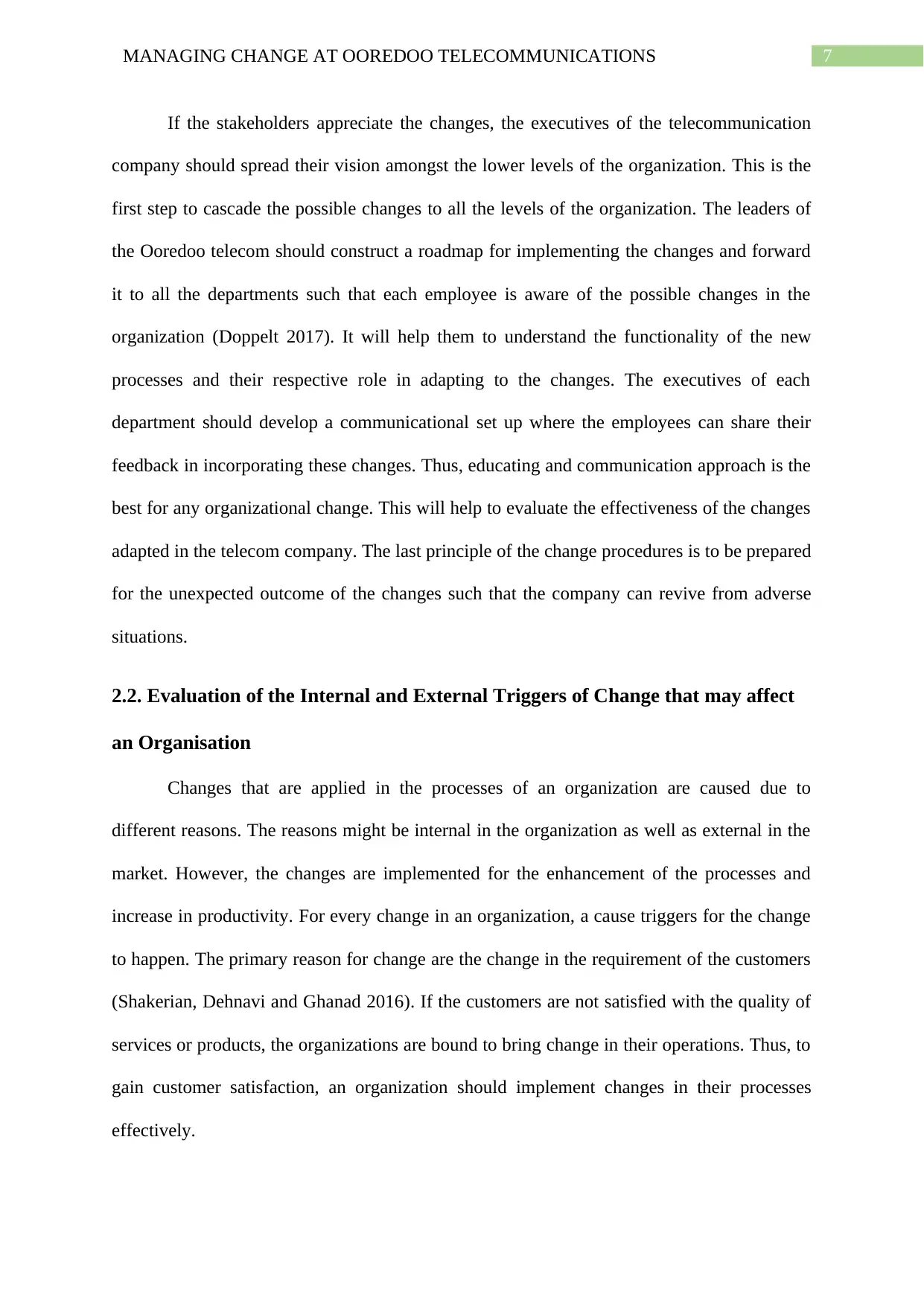
7MANAGING CHANGE AT OOREDOO TELECOMMUNICATIONS
If the stakeholders appreciate the changes, the executives of the telecommunication
company should spread their vision amongst the lower levels of the organization. This is the
first step to cascade the possible changes to all the levels of the organization. The leaders of
the Ooredoo telecom should construct a roadmap for implementing the changes and forward
it to all the departments such that each employee is aware of the possible changes in the
organization (Doppelt 2017). It will help them to understand the functionality of the new
processes and their respective role in adapting to the changes. The executives of each
department should develop a communicational set up where the employees can share their
feedback in incorporating these changes. Thus, educating and communication approach is the
best for any organizational change. This will help to evaluate the effectiveness of the changes
adapted in the telecom company. The last principle of the change procedures is to be prepared
for the unexpected outcome of the changes such that the company can revive from adverse
situations.
2.2. Evaluation of the Internal and External Triggers of Change that may affect
an Organisation
Changes that are applied in the processes of an organization are caused due to
different reasons. The reasons might be internal in the organization as well as external in the
market. However, the changes are implemented for the enhancement of the processes and
increase in productivity. For every change in an organization, a cause triggers for the change
to happen. The primary reason for change are the change in the requirement of the customers
(Shakerian, Dehnavi and Ghanad 2016). If the customers are not satisfied with the quality of
services or products, the organizations are bound to bring change in their operations. Thus, to
gain customer satisfaction, an organization should implement changes in their processes
effectively.
If the stakeholders appreciate the changes, the executives of the telecommunication
company should spread their vision amongst the lower levels of the organization. This is the
first step to cascade the possible changes to all the levels of the organization. The leaders of
the Ooredoo telecom should construct a roadmap for implementing the changes and forward
it to all the departments such that each employee is aware of the possible changes in the
organization (Doppelt 2017). It will help them to understand the functionality of the new
processes and their respective role in adapting to the changes. The executives of each
department should develop a communicational set up where the employees can share their
feedback in incorporating these changes. Thus, educating and communication approach is the
best for any organizational change. This will help to evaluate the effectiveness of the changes
adapted in the telecom company. The last principle of the change procedures is to be prepared
for the unexpected outcome of the changes such that the company can revive from adverse
situations.
2.2. Evaluation of the Internal and External Triggers of Change that may affect
an Organisation
Changes that are applied in the processes of an organization are caused due to
different reasons. The reasons might be internal in the organization as well as external in the
market. However, the changes are implemented for the enhancement of the processes and
increase in productivity. For every change in an organization, a cause triggers for the change
to happen. The primary reason for change are the change in the requirement of the customers
(Shakerian, Dehnavi and Ghanad 2016). If the customers are not satisfied with the quality of
services or products, the organizations are bound to bring change in their operations. Thus, to
gain customer satisfaction, an organization should implement changes in their processes
effectively.
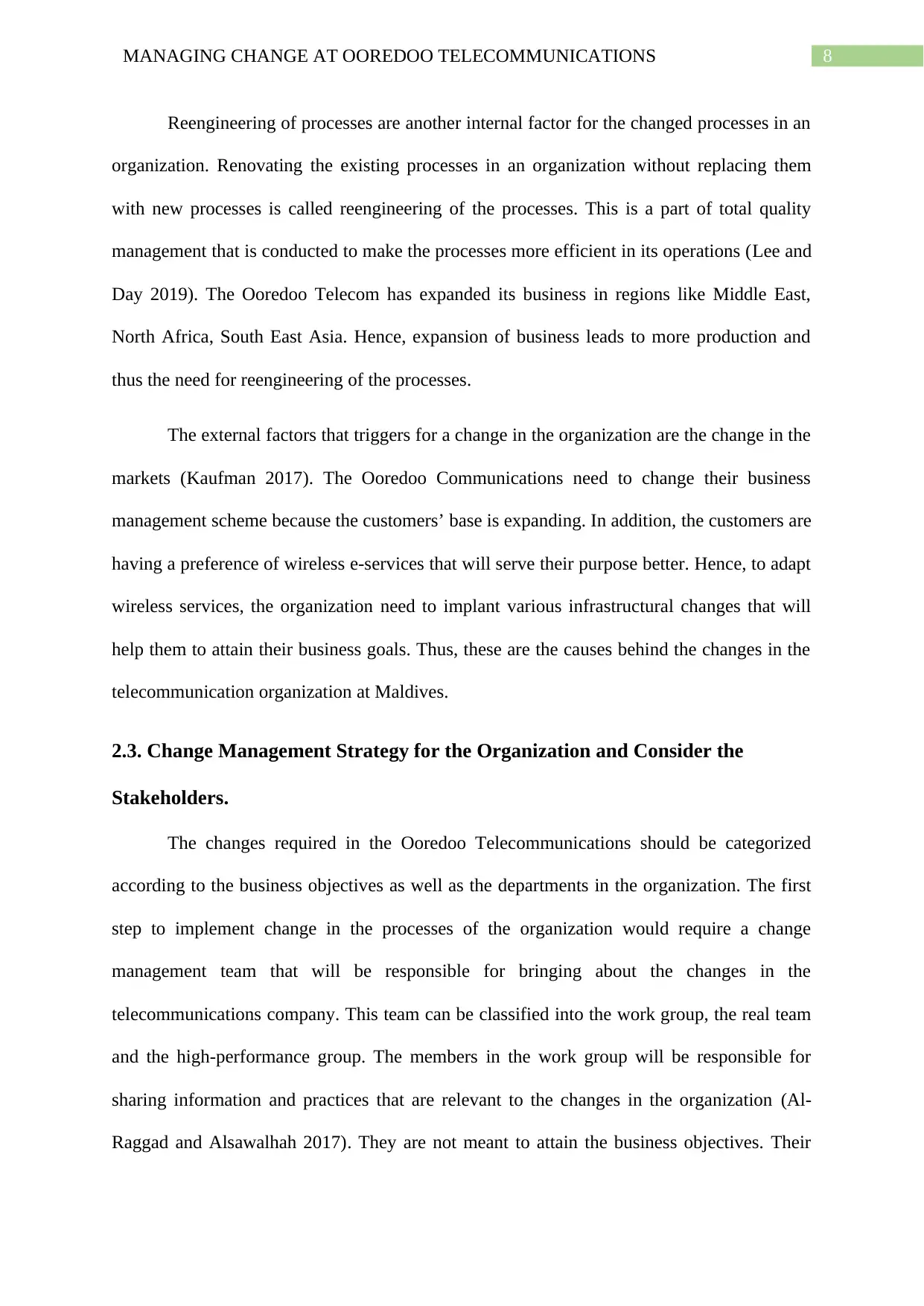
8MANAGING CHANGE AT OOREDOO TELECOMMUNICATIONS
Reengineering of processes are another internal factor for the changed processes in an
organization. Renovating the existing processes in an organization without replacing them
with new processes is called reengineering of the processes. This is a part of total quality
management that is conducted to make the processes more efficient in its operations (Lee and
Day 2019). The Ooredoo Telecom has expanded its business in regions like Middle East,
North Africa, South East Asia. Hence, expansion of business leads to more production and
thus the need for reengineering of the processes.
The external factors that triggers for a change in the organization are the change in the
markets (Kaufman 2017). The Ooredoo Communications need to change their business
management scheme because the customers’ base is expanding. In addition, the customers are
having a preference of wireless e-services that will serve their purpose better. Hence, to adapt
wireless services, the organization need to implant various infrastructural changes that will
help them to attain their business goals. Thus, these are the causes behind the changes in the
telecommunication organization at Maldives.
2.3. Change Management Strategy for the Organization and Consider the
Stakeholders.
The changes required in the Ooredoo Telecommunications should be categorized
according to the business objectives as well as the departments in the organization. The first
step to implement change in the processes of the organization would require a change
management team that will be responsible for bringing about the changes in the
telecommunications company. This team can be classified into the work group, the real team
and the high-performance group. The members in the work group will be responsible for
sharing information and practices that are relevant to the changes in the organization (Al-
Raggad and Alsawalhah 2017). They are not meant to attain the business objectives. Their
Reengineering of processes are another internal factor for the changed processes in an
organization. Renovating the existing processes in an organization without replacing them
with new processes is called reengineering of the processes. This is a part of total quality
management that is conducted to make the processes more efficient in its operations (Lee and
Day 2019). The Ooredoo Telecom has expanded its business in regions like Middle East,
North Africa, South East Asia. Hence, expansion of business leads to more production and
thus the need for reengineering of the processes.
The external factors that triggers for a change in the organization are the change in the
markets (Kaufman 2017). The Ooredoo Communications need to change their business
management scheme because the customers’ base is expanding. In addition, the customers are
having a preference of wireless e-services that will serve their purpose better. Hence, to adapt
wireless services, the organization need to implant various infrastructural changes that will
help them to attain their business goals. Thus, these are the causes behind the changes in the
telecommunication organization at Maldives.
2.3. Change Management Strategy for the Organization and Consider the
Stakeholders.
The changes required in the Ooredoo Telecommunications should be categorized
according to the business objectives as well as the departments in the organization. The first
step to implement change in the processes of the organization would require a change
management team that will be responsible for bringing about the changes in the
telecommunications company. This team can be classified into the work group, the real team
and the high-performance group. The members in the work group will be responsible for
sharing information and practices that are relevant to the changes in the organization (Al-
Raggad and Alsawalhah 2017). They are not meant to attain the business objectives. Their
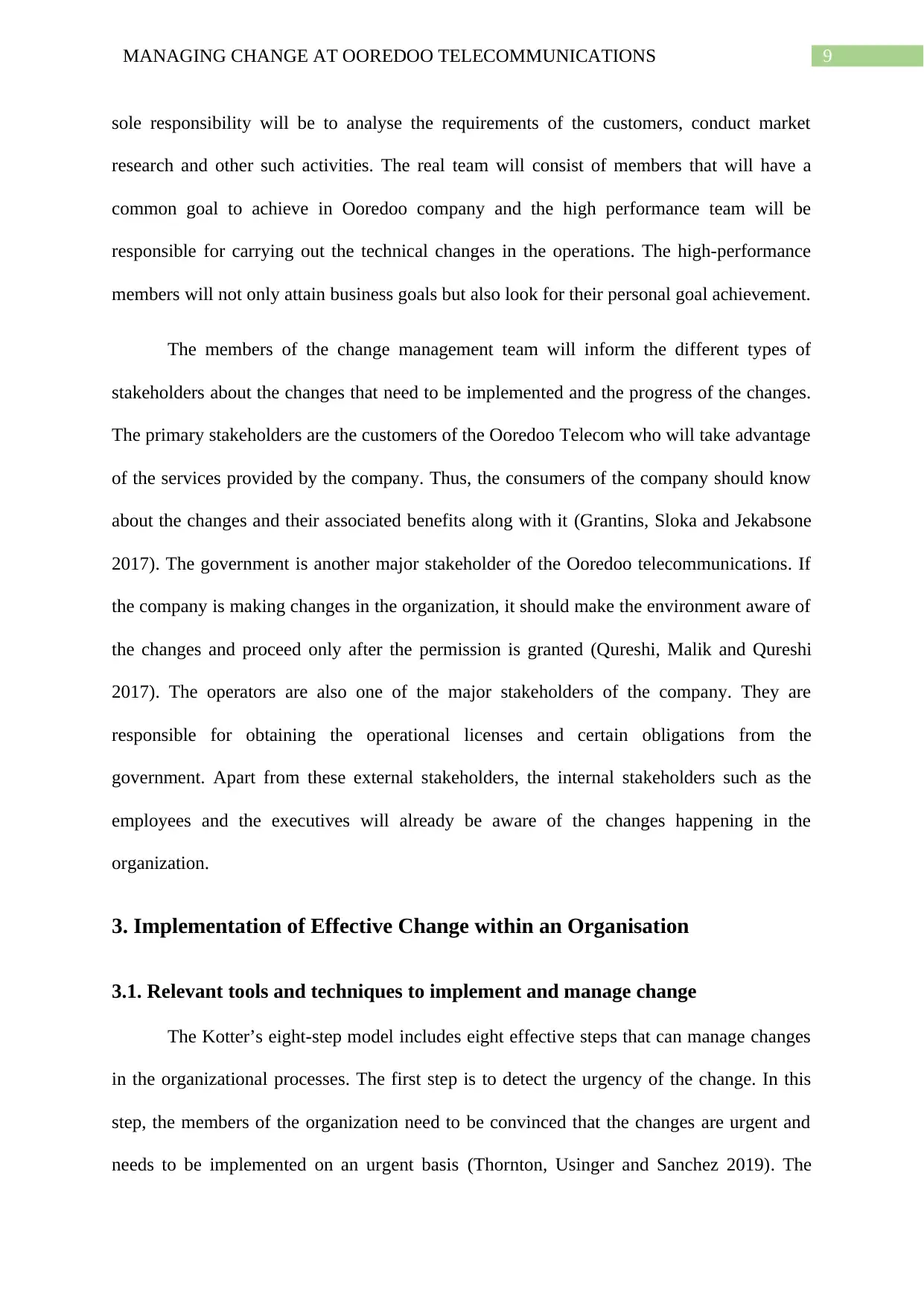
9MANAGING CHANGE AT OOREDOO TELECOMMUNICATIONS
sole responsibility will be to analyse the requirements of the customers, conduct market
research and other such activities. The real team will consist of members that will have a
common goal to achieve in Ooredoo company and the high performance team will be
responsible for carrying out the technical changes in the operations. The high-performance
members will not only attain business goals but also look for their personal goal achievement.
The members of the change management team will inform the different types of
stakeholders about the changes that need to be implemented and the progress of the changes.
The primary stakeholders are the customers of the Ooredoo Telecom who will take advantage
of the services provided by the company. Thus, the consumers of the company should know
about the changes and their associated benefits along with it (Grantins, Sloka and Jekabsone
2017). The government is another major stakeholder of the Ooredoo telecommunications. If
the company is making changes in the organization, it should make the environment aware of
the changes and proceed only after the permission is granted (Qureshi, Malik and Qureshi
2017). The operators are also one of the major stakeholders of the company. They are
responsible for obtaining the operational licenses and certain obligations from the
government. Apart from these external stakeholders, the internal stakeholders such as the
employees and the executives will already be aware of the changes happening in the
organization.
3. Implementation of Effective Change within an Organisation
3.1. Relevant tools and techniques to implement and manage change
The Kotter’s eight-step model includes eight effective steps that can manage changes
in the organizational processes. The first step is to detect the urgency of the change. In this
step, the members of the organization need to be convinced that the changes are urgent and
needs to be implemented on an urgent basis (Thornton, Usinger and Sanchez 2019). The
sole responsibility will be to analyse the requirements of the customers, conduct market
research and other such activities. The real team will consist of members that will have a
common goal to achieve in Ooredoo company and the high performance team will be
responsible for carrying out the technical changes in the operations. The high-performance
members will not only attain business goals but also look for their personal goal achievement.
The members of the change management team will inform the different types of
stakeholders about the changes that need to be implemented and the progress of the changes.
The primary stakeholders are the customers of the Ooredoo Telecom who will take advantage
of the services provided by the company. Thus, the consumers of the company should know
about the changes and their associated benefits along with it (Grantins, Sloka and Jekabsone
2017). The government is another major stakeholder of the Ooredoo telecommunications. If
the company is making changes in the organization, it should make the environment aware of
the changes and proceed only after the permission is granted (Qureshi, Malik and Qureshi
2017). The operators are also one of the major stakeholders of the company. They are
responsible for obtaining the operational licenses and certain obligations from the
government. Apart from these external stakeholders, the internal stakeholders such as the
employees and the executives will already be aware of the changes happening in the
organization.
3. Implementation of Effective Change within an Organisation
3.1. Relevant tools and techniques to implement and manage change
The Kotter’s eight-step model includes eight effective steps that can manage changes
in the organizational processes. The first step is to detect the urgency of the change. In this
step, the members of the organization need to be convinced that the changes are urgent and
needs to be implemented on an urgent basis (Thornton, Usinger and Sanchez 2019). The
Secure Best Marks with AI Grader
Need help grading? Try our AI Grader for instant feedback on your assignments.
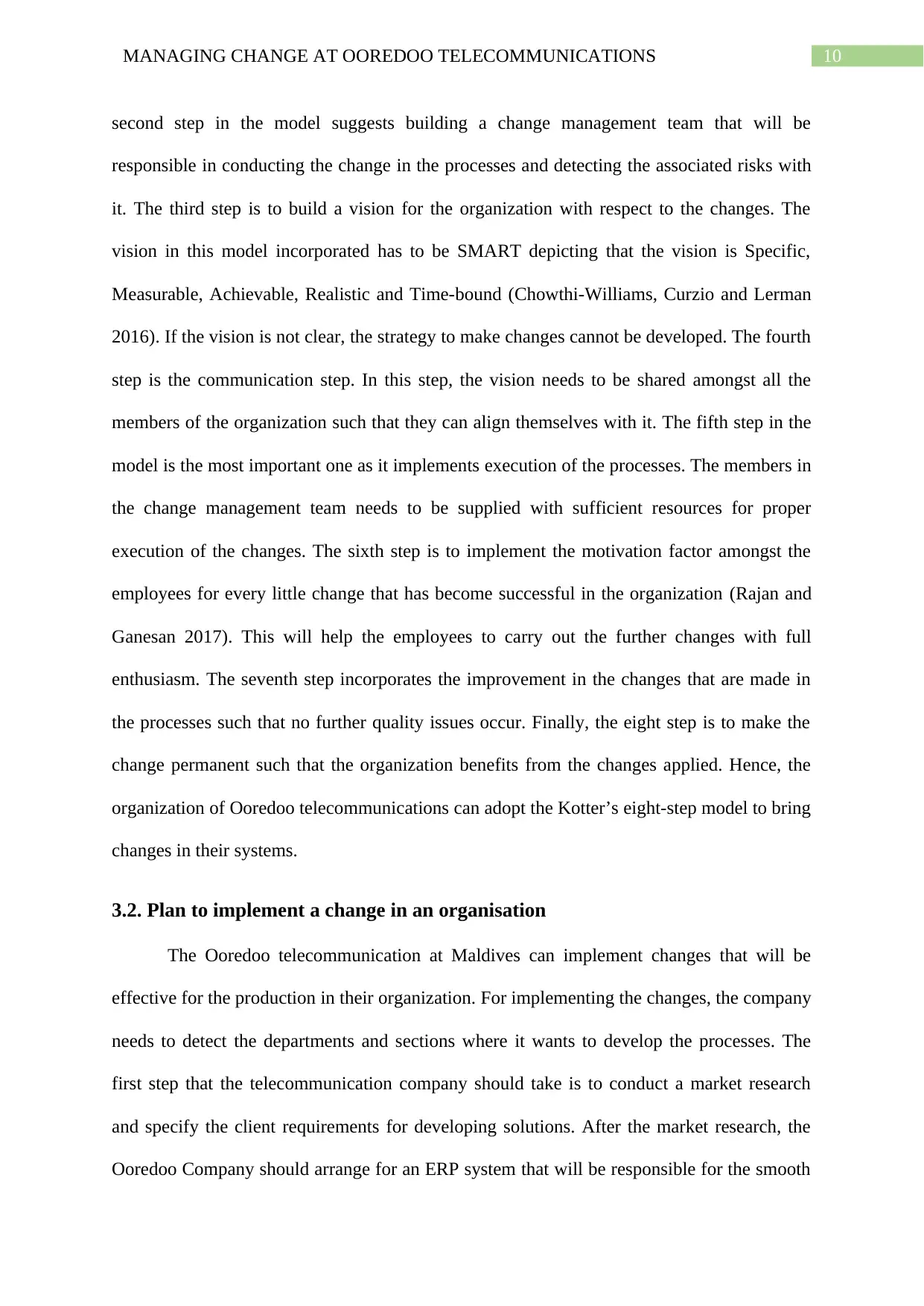
10MANAGING CHANGE AT OOREDOO TELECOMMUNICATIONS
second step in the model suggests building a change management team that will be
responsible in conducting the change in the processes and detecting the associated risks with
it. The third step is to build a vision for the organization with respect to the changes. The
vision in this model incorporated has to be SMART depicting that the vision is Specific,
Measurable, Achievable, Realistic and Time-bound (Chowthi-Williams, Curzio and Lerman
2016). If the vision is not clear, the strategy to make changes cannot be developed. The fourth
step is the communication step. In this step, the vision needs to be shared amongst all the
members of the organization such that they can align themselves with it. The fifth step in the
model is the most important one as it implements execution of the processes. The members in
the change management team needs to be supplied with sufficient resources for proper
execution of the changes. The sixth step is to implement the motivation factor amongst the
employees for every little change that has become successful in the organization (Rajan and
Ganesan 2017). This will help the employees to carry out the further changes with full
enthusiasm. The seventh step incorporates the improvement in the changes that are made in
the processes such that no further quality issues occur. Finally, the eight step is to make the
change permanent such that the organization benefits from the changes applied. Hence, the
organization of Ooredoo telecommunications can adopt the Kotter’s eight-step model to bring
changes in their systems.
3.2. Plan to implement a change in an organisation
The Ooredoo telecommunication at Maldives can implement changes that will be
effective for the production in their organization. For implementing the changes, the company
needs to detect the departments and sections where it wants to develop the processes. The
first step that the telecommunication company should take is to conduct a market research
and specify the client requirements for developing solutions. After the market research, the
Ooredoo Company should arrange for an ERP system that will be responsible for the smooth
second step in the model suggests building a change management team that will be
responsible in conducting the change in the processes and detecting the associated risks with
it. The third step is to build a vision for the organization with respect to the changes. The
vision in this model incorporated has to be SMART depicting that the vision is Specific,
Measurable, Achievable, Realistic and Time-bound (Chowthi-Williams, Curzio and Lerman
2016). If the vision is not clear, the strategy to make changes cannot be developed. The fourth
step is the communication step. In this step, the vision needs to be shared amongst all the
members of the organization such that they can align themselves with it. The fifth step in the
model is the most important one as it implements execution of the processes. The members in
the change management team needs to be supplied with sufficient resources for proper
execution of the changes. The sixth step is to implement the motivation factor amongst the
employees for every little change that has become successful in the organization (Rajan and
Ganesan 2017). This will help the employees to carry out the further changes with full
enthusiasm. The seventh step incorporates the improvement in the changes that are made in
the processes such that no further quality issues occur. Finally, the eight step is to make the
change permanent such that the organization benefits from the changes applied. Hence, the
organization of Ooredoo telecommunications can adopt the Kotter’s eight-step model to bring
changes in their systems.
3.2. Plan to implement a change in an organisation
The Ooredoo telecommunication at Maldives can implement changes that will be
effective for the production in their organization. For implementing the changes, the company
needs to detect the departments and sections where it wants to develop the processes. The
first step that the telecommunication company should take is to conduct a market research
and specify the client requirements for developing solutions. After the market research, the
Ooredoo Company should arrange for an ERP system that will be responsible for the smooth
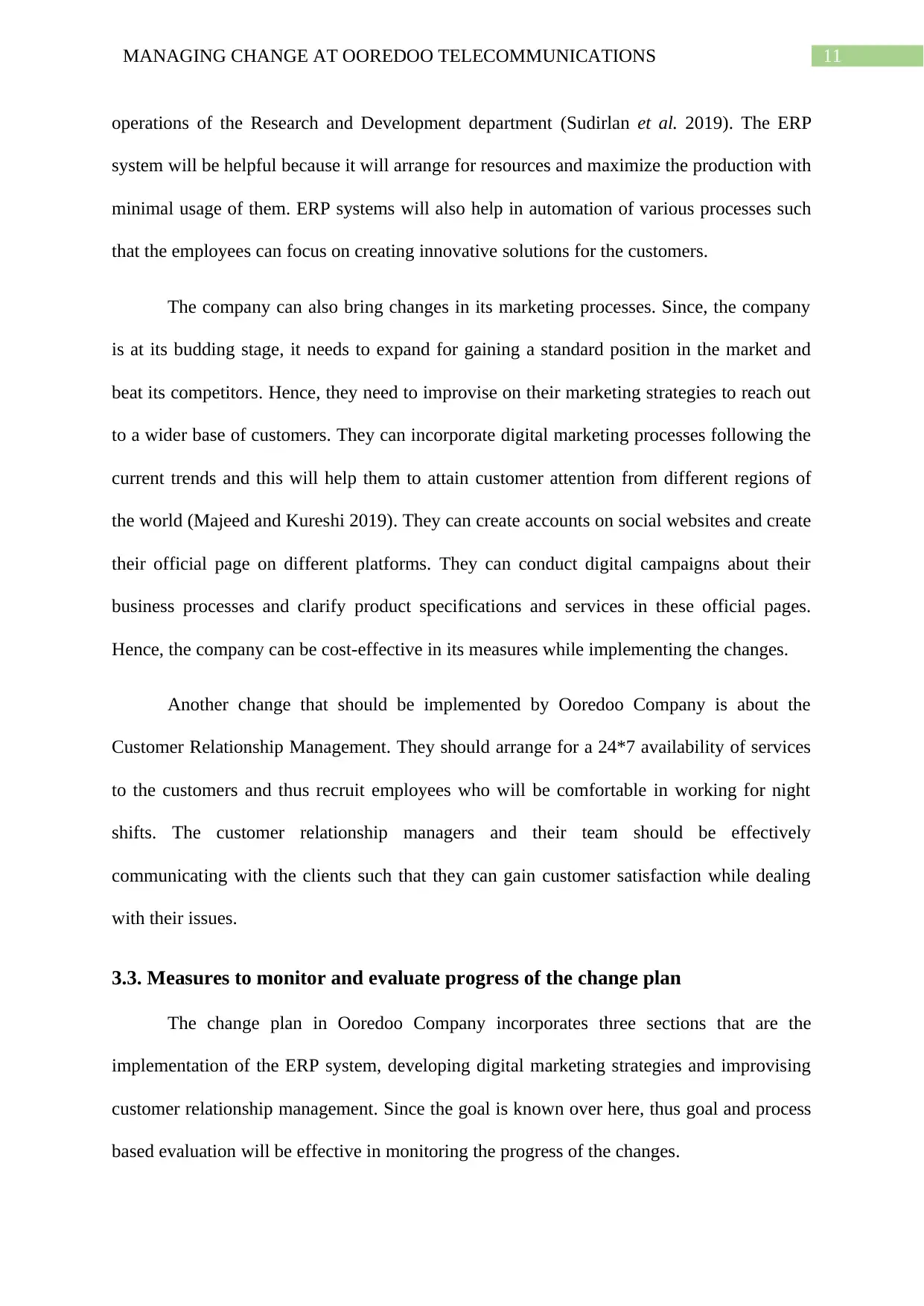
11MANAGING CHANGE AT OOREDOO TELECOMMUNICATIONS
operations of the Research and Development department (Sudirlan et al. 2019). The ERP
system will be helpful because it will arrange for resources and maximize the production with
minimal usage of them. ERP systems will also help in automation of various processes such
that the employees can focus on creating innovative solutions for the customers.
The company can also bring changes in its marketing processes. Since, the company
is at its budding stage, it needs to expand for gaining a standard position in the market and
beat its competitors. Hence, they need to improvise on their marketing strategies to reach out
to a wider base of customers. They can incorporate digital marketing processes following the
current trends and this will help them to attain customer attention from different regions of
the world (Majeed and Kureshi 2019). They can create accounts on social websites and create
their official page on different platforms. They can conduct digital campaigns about their
business processes and clarify product specifications and services in these official pages.
Hence, the company can be cost-effective in its measures while implementing the changes.
Another change that should be implemented by Ooredoo Company is about the
Customer Relationship Management. They should arrange for a 24*7 availability of services
to the customers and thus recruit employees who will be comfortable in working for night
shifts. The customer relationship managers and their team should be effectively
communicating with the clients such that they can gain customer satisfaction while dealing
with their issues.
3.3. Measures to monitor and evaluate progress of the change plan
The change plan in Ooredoo Company incorporates three sections that are the
implementation of the ERP system, developing digital marketing strategies and improvising
customer relationship management. Since the goal is known over here, thus goal and process
based evaluation will be effective in monitoring the progress of the changes.
operations of the Research and Development department (Sudirlan et al. 2019). The ERP
system will be helpful because it will arrange for resources and maximize the production with
minimal usage of them. ERP systems will also help in automation of various processes such
that the employees can focus on creating innovative solutions for the customers.
The company can also bring changes in its marketing processes. Since, the company
is at its budding stage, it needs to expand for gaining a standard position in the market and
beat its competitors. Hence, they need to improvise on their marketing strategies to reach out
to a wider base of customers. They can incorporate digital marketing processes following the
current trends and this will help them to attain customer attention from different regions of
the world (Majeed and Kureshi 2019). They can create accounts on social websites and create
their official page on different platforms. They can conduct digital campaigns about their
business processes and clarify product specifications and services in these official pages.
Hence, the company can be cost-effective in its measures while implementing the changes.
Another change that should be implemented by Ooredoo Company is about the
Customer Relationship Management. They should arrange for a 24*7 availability of services
to the customers and thus recruit employees who will be comfortable in working for night
shifts. The customer relationship managers and their team should be effectively
communicating with the clients such that they can gain customer satisfaction while dealing
with their issues.
3.3. Measures to monitor and evaluate progress of the change plan
The change plan in Ooredoo Company incorporates three sections that are the
implementation of the ERP system, developing digital marketing strategies and improvising
customer relationship management. Since the goal is known over here, thus goal and process
based evaluation will be effective in monitoring the progress of the changes.
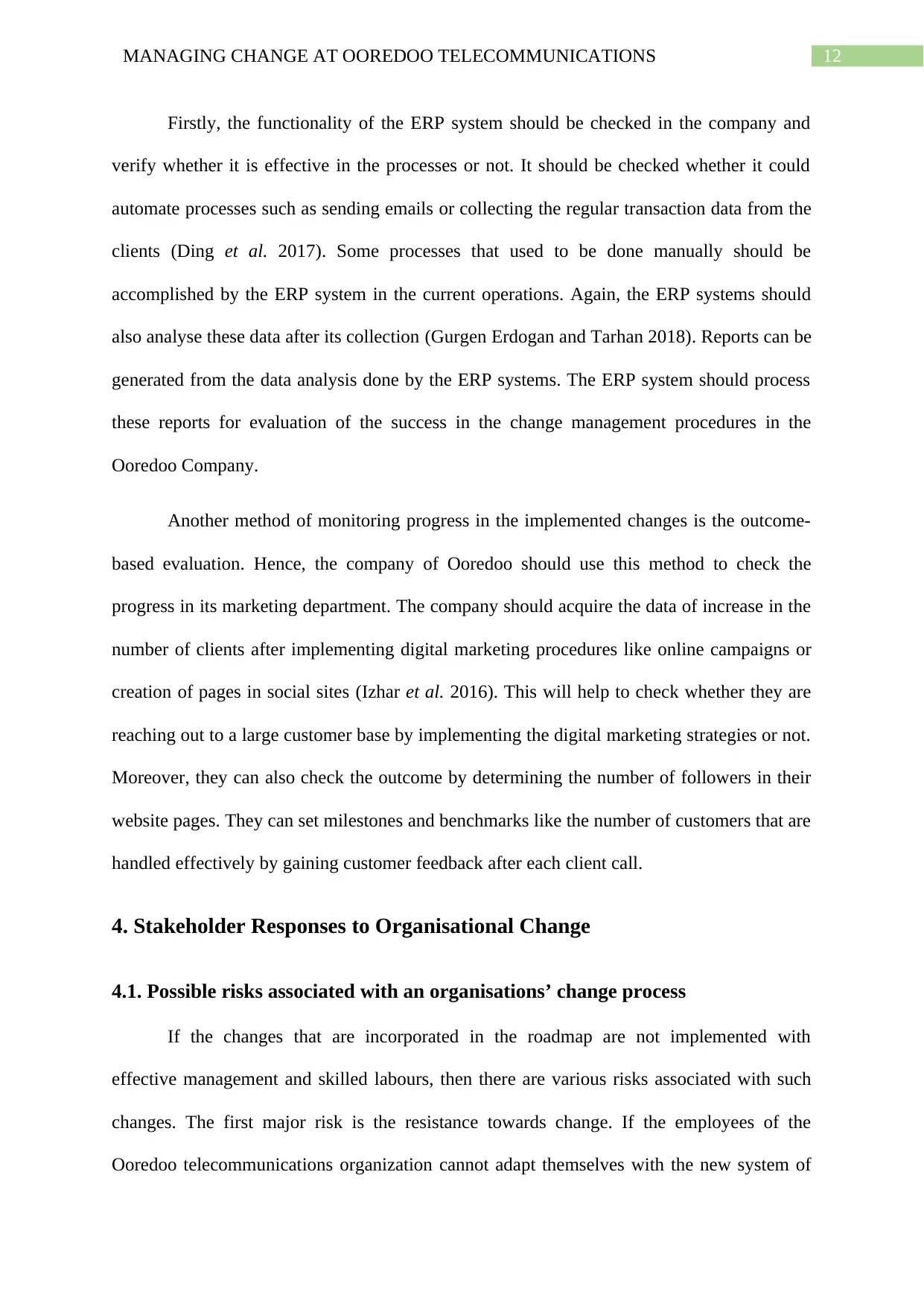
12MANAGING CHANGE AT OOREDOO TELECOMMUNICATIONS
Firstly, the functionality of the ERP system should be checked in the company and
verify whether it is effective in the processes or not. It should be checked whether it could
automate processes such as sending emails or collecting the regular transaction data from the
clients (Ding et al. 2017). Some processes that used to be done manually should be
accomplished by the ERP system in the current operations. Again, the ERP systems should
also analyse these data after its collection (Gurgen Erdogan and Tarhan 2018). Reports can be
generated from the data analysis done by the ERP systems. The ERP system should process
these reports for evaluation of the success in the change management procedures in the
Ooredoo Company.
Another method of monitoring progress in the implemented changes is the outcome-
based evaluation. Hence, the company of Ooredoo should use this method to check the
progress in its marketing department. The company should acquire the data of increase in the
number of clients after implementing digital marketing procedures like online campaigns or
creation of pages in social sites (Izhar et al. 2016). This will help to check whether they are
reaching out to a large customer base by implementing the digital marketing strategies or not.
Moreover, they can also check the outcome by determining the number of followers in their
website pages. They can set milestones and benchmarks like the number of customers that are
handled effectively by gaining customer feedback after each client call.
4. Stakeholder Responses to Organisational Change
4.1. Possible risks associated with an organisations’ change process
If the changes that are incorporated in the roadmap are not implemented with
effective management and skilled labours, then there are various risks associated with such
changes. The first major risk is the resistance towards change. If the employees of the
Ooredoo telecommunications organization cannot adapt themselves with the new system of
Firstly, the functionality of the ERP system should be checked in the company and
verify whether it is effective in the processes or not. It should be checked whether it could
automate processes such as sending emails or collecting the regular transaction data from the
clients (Ding et al. 2017). Some processes that used to be done manually should be
accomplished by the ERP system in the current operations. Again, the ERP systems should
also analyse these data after its collection (Gurgen Erdogan and Tarhan 2018). Reports can be
generated from the data analysis done by the ERP systems. The ERP system should process
these reports for evaluation of the success in the change management procedures in the
Ooredoo Company.
Another method of monitoring progress in the implemented changes is the outcome-
based evaluation. Hence, the company of Ooredoo should use this method to check the
progress in its marketing department. The company should acquire the data of increase in the
number of clients after implementing digital marketing procedures like online campaigns or
creation of pages in social sites (Izhar et al. 2016). This will help to check whether they are
reaching out to a large customer base by implementing the digital marketing strategies or not.
Moreover, they can also check the outcome by determining the number of followers in their
website pages. They can set milestones and benchmarks like the number of customers that are
handled effectively by gaining customer feedback after each client call.
4. Stakeholder Responses to Organisational Change
4.1. Possible risks associated with an organisations’ change process
If the changes that are incorporated in the roadmap are not implemented with
effective management and skilled labours, then there are various risks associated with such
changes. The first major risk is the resistance towards change. If the employees of the
Ooredoo telecommunications organization cannot adapt themselves with the new system of
Paraphrase This Document
Need a fresh take? Get an instant paraphrase of this document with our AI Paraphraser
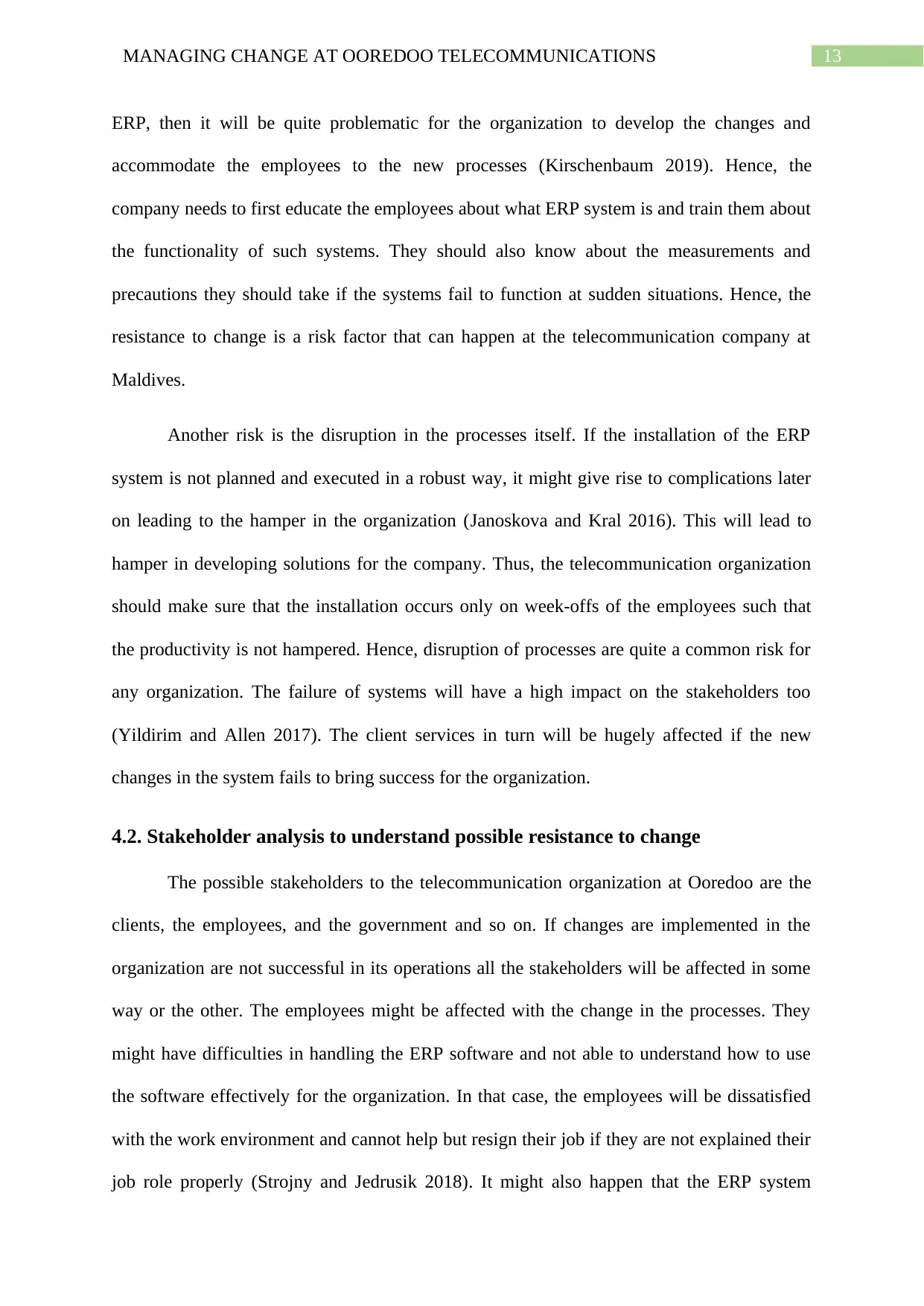
13MANAGING CHANGE AT OOREDOO TELECOMMUNICATIONS
ERP, then it will be quite problematic for the organization to develop the changes and
accommodate the employees to the new processes (Kirschenbaum 2019). Hence, the
company needs to first educate the employees about what ERP system is and train them about
the functionality of such systems. They should also know about the measurements and
precautions they should take if the systems fail to function at sudden situations. Hence, the
resistance to change is a risk factor that can happen at the telecommunication company at
Maldives.
Another risk is the disruption in the processes itself. If the installation of the ERP
system is not planned and executed in a robust way, it might give rise to complications later
on leading to the hamper in the organization (Janoskova and Kral 2016). This will lead to
hamper in developing solutions for the company. Thus, the telecommunication organization
should make sure that the installation occurs only on week-offs of the employees such that
the productivity is not hampered. Hence, disruption of processes are quite a common risk for
any organization. The failure of systems will have a high impact on the stakeholders too
(Yildirim and Allen 2017). The client services in turn will be hugely affected if the new
changes in the system fails to bring success for the organization.
4.2. Stakeholder analysis to understand possible resistance to change
The possible stakeholders to the telecommunication organization at Ooredoo are the
clients, the employees, and the government and so on. If changes are implemented in the
organization are not successful in its operations all the stakeholders will be affected in some
way or the other. The employees might be affected with the change in the processes. They
might have difficulties in handling the ERP software and not able to understand how to use
the software effectively for the organization. In that case, the employees will be dissatisfied
with the work environment and cannot help but resign their job if they are not explained their
job role properly (Strojny and Jedrusik 2018). It might also happen that the ERP system
ERP, then it will be quite problematic for the organization to develop the changes and
accommodate the employees to the new processes (Kirschenbaum 2019). Hence, the
company needs to first educate the employees about what ERP system is and train them about
the functionality of such systems. They should also know about the measurements and
precautions they should take if the systems fail to function at sudden situations. Hence, the
resistance to change is a risk factor that can happen at the telecommunication company at
Maldives.
Another risk is the disruption in the processes itself. If the installation of the ERP
system is not planned and executed in a robust way, it might give rise to complications later
on leading to the hamper in the organization (Janoskova and Kral 2016). This will lead to
hamper in developing solutions for the company. Thus, the telecommunication organization
should make sure that the installation occurs only on week-offs of the employees such that
the productivity is not hampered. Hence, disruption of processes are quite a common risk for
any organization. The failure of systems will have a high impact on the stakeholders too
(Yildirim and Allen 2017). The client services in turn will be hugely affected if the new
changes in the system fails to bring success for the organization.
4.2. Stakeholder analysis to understand possible resistance to change
The possible stakeholders to the telecommunication organization at Ooredoo are the
clients, the employees, and the government and so on. If changes are implemented in the
organization are not successful in its operations all the stakeholders will be affected in some
way or the other. The employees might be affected with the change in the processes. They
might have difficulties in handling the ERP software and not able to understand how to use
the software effectively for the organization. In that case, the employees will be dissatisfied
with the work environment and cannot help but resign their job if they are not explained their
job role properly (Strojny and Jedrusik 2018). It might also happen that the ERP system
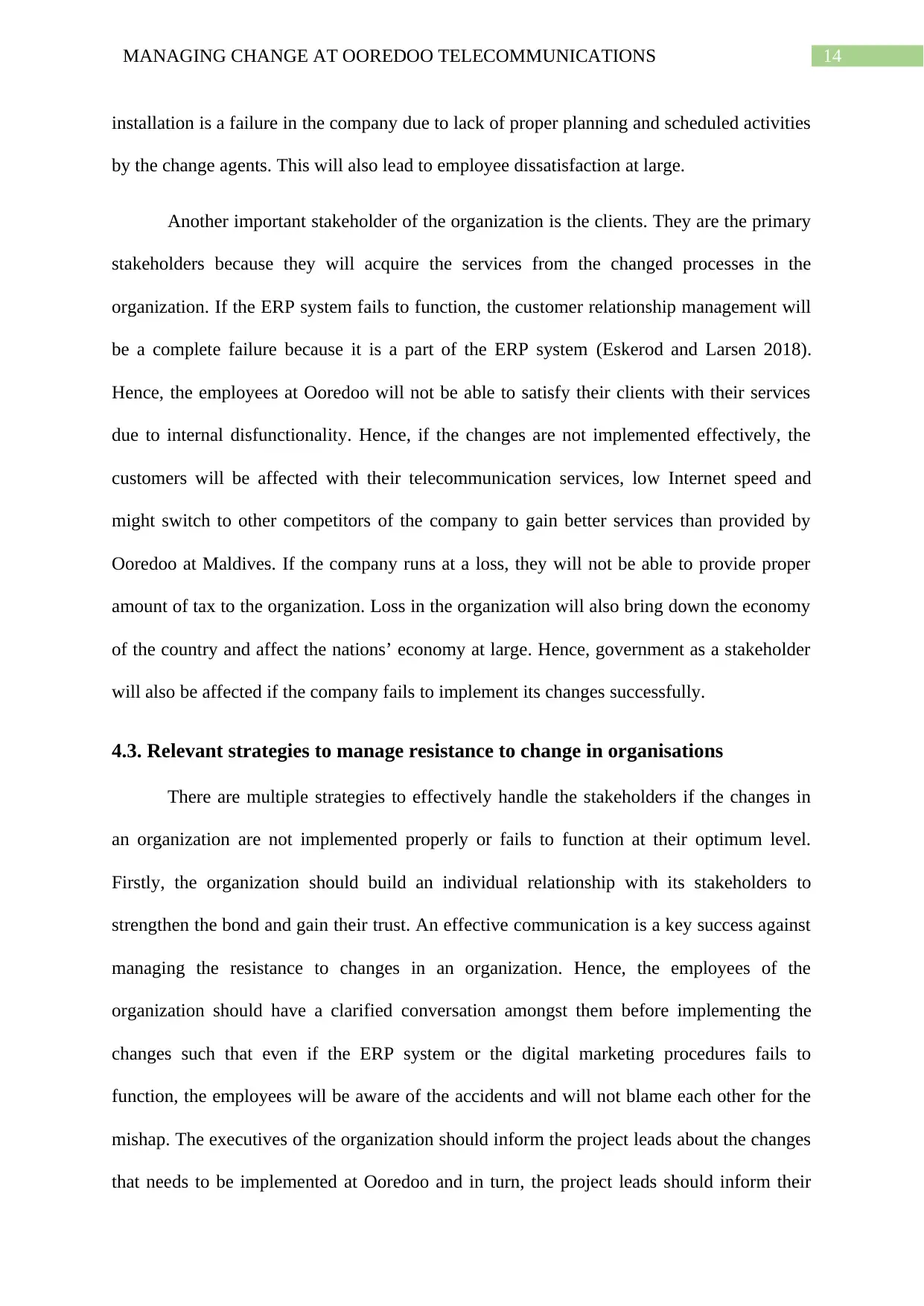
14MANAGING CHANGE AT OOREDOO TELECOMMUNICATIONS
installation is a failure in the company due to lack of proper planning and scheduled activities
by the change agents. This will also lead to employee dissatisfaction at large.
Another important stakeholder of the organization is the clients. They are the primary
stakeholders because they will acquire the services from the changed processes in the
organization. If the ERP system fails to function, the customer relationship management will
be a complete failure because it is a part of the ERP system (Eskerod and Larsen 2018).
Hence, the employees at Ooredoo will not be able to satisfy their clients with their services
due to internal disfunctionality. Hence, if the changes are not implemented effectively, the
customers will be affected with their telecommunication services, low Internet speed and
might switch to other competitors of the company to gain better services than provided by
Ooredoo at Maldives. If the company runs at a loss, they will not be able to provide proper
amount of tax to the organization. Loss in the organization will also bring down the economy
of the country and affect the nations’ economy at large. Hence, government as a stakeholder
will also be affected if the company fails to implement its changes successfully.
4.3. Relevant strategies to manage resistance to change in organisations
There are multiple strategies to effectively handle the stakeholders if the changes in
an organization are not implemented properly or fails to function at their optimum level.
Firstly, the organization should build an individual relationship with its stakeholders to
strengthen the bond and gain their trust. An effective communication is a key success against
managing the resistance to changes in an organization. Hence, the employees of the
organization should have a clarified conversation amongst them before implementing the
changes such that even if the ERP system or the digital marketing procedures fails to
function, the employees will be aware of the accidents and will not blame each other for the
mishap. The executives of the organization should inform the project leads about the changes
that needs to be implemented at Ooredoo and in turn, the project leads should inform their
installation is a failure in the company due to lack of proper planning and scheduled activities
by the change agents. This will also lead to employee dissatisfaction at large.
Another important stakeholder of the organization is the clients. They are the primary
stakeholders because they will acquire the services from the changed processes in the
organization. If the ERP system fails to function, the customer relationship management will
be a complete failure because it is a part of the ERP system (Eskerod and Larsen 2018).
Hence, the employees at Ooredoo will not be able to satisfy their clients with their services
due to internal disfunctionality. Hence, if the changes are not implemented effectively, the
customers will be affected with their telecommunication services, low Internet speed and
might switch to other competitors of the company to gain better services than provided by
Ooredoo at Maldives. If the company runs at a loss, they will not be able to provide proper
amount of tax to the organization. Loss in the organization will also bring down the economy
of the country and affect the nations’ economy at large. Hence, government as a stakeholder
will also be affected if the company fails to implement its changes successfully.
4.3. Relevant strategies to manage resistance to change in organisations
There are multiple strategies to effectively handle the stakeholders if the changes in
an organization are not implemented properly or fails to function at their optimum level.
Firstly, the organization should build an individual relationship with its stakeholders to
strengthen the bond and gain their trust. An effective communication is a key success against
managing the resistance to changes in an organization. Hence, the employees of the
organization should have a clarified conversation amongst them before implementing the
changes such that even if the ERP system or the digital marketing procedures fails to
function, the employees will be aware of the accidents and will not blame each other for the
mishap. The executives of the organization should inform the project leads about the changes
that needs to be implemented at Ooredoo and in turn, the project leads should inform their
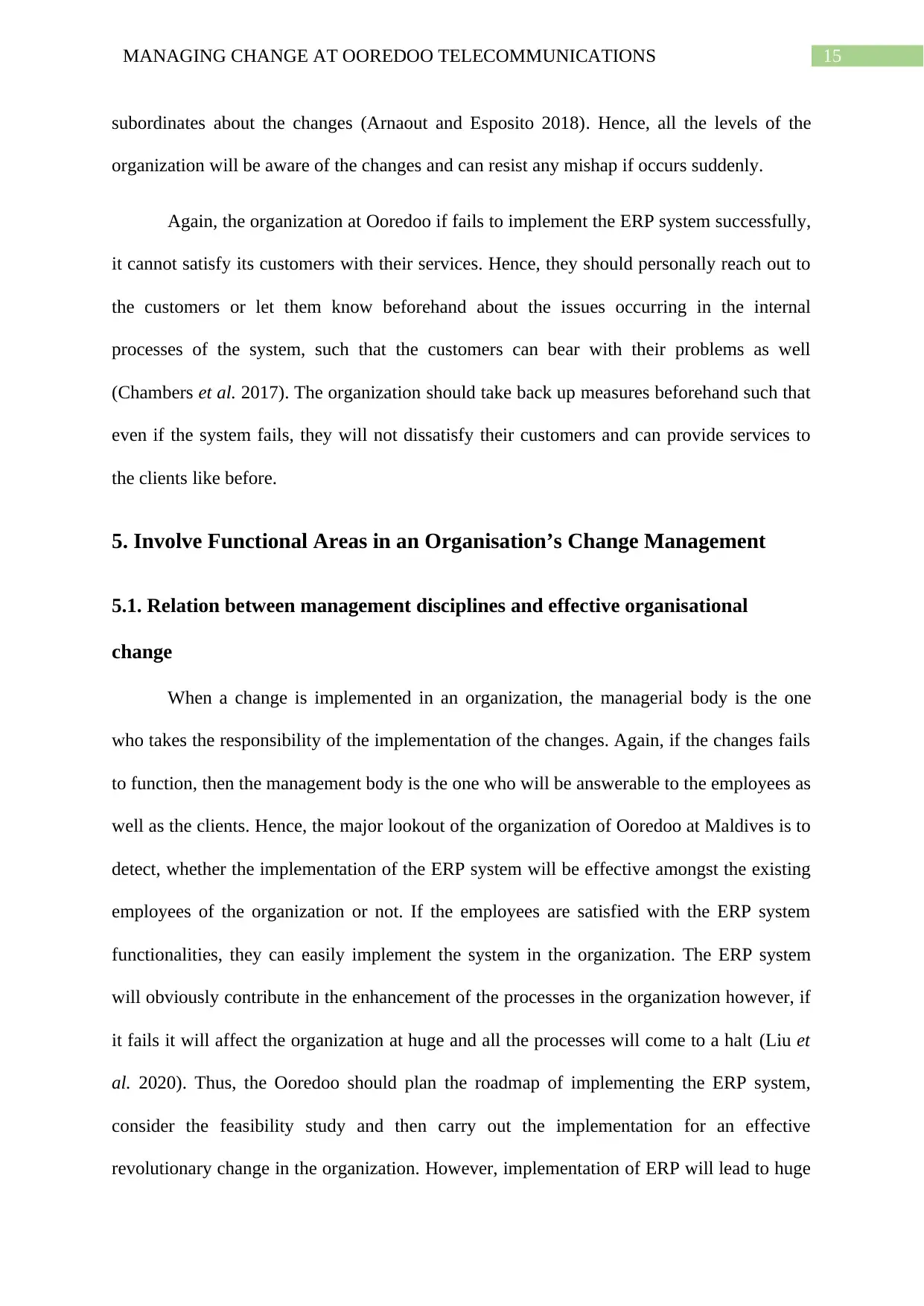
15MANAGING CHANGE AT OOREDOO TELECOMMUNICATIONS
subordinates about the changes (Arnaout and Esposito 2018). Hence, all the levels of the
organization will be aware of the changes and can resist any mishap if occurs suddenly.
Again, the organization at Ooredoo if fails to implement the ERP system successfully,
it cannot satisfy its customers with their services. Hence, they should personally reach out to
the customers or let them know beforehand about the issues occurring in the internal
processes of the system, such that the customers can bear with their problems as well
(Chambers et al. 2017). The organization should take back up measures beforehand such that
even if the system fails, they will not dissatisfy their customers and can provide services to
the clients like before.
5. Involve Functional Areas in an Organisation’s Change Management
5.1. Relation between management disciplines and effective organisational
change
When a change is implemented in an organization, the managerial body is the one
who takes the responsibility of the implementation of the changes. Again, if the changes fails
to function, then the management body is the one who will be answerable to the employees as
well as the clients. Hence, the major lookout of the organization of Ooredoo at Maldives is to
detect, whether the implementation of the ERP system will be effective amongst the existing
employees of the organization or not. If the employees are satisfied with the ERP system
functionalities, they can easily implement the system in the organization. The ERP system
will obviously contribute in the enhancement of the processes in the organization however, if
it fails it will affect the organization at huge and all the processes will come to a halt (Liu et
al. 2020). Thus, the Ooredoo should plan the roadmap of implementing the ERP system,
consider the feasibility study and then carry out the implementation for an effective
revolutionary change in the organization. However, implementation of ERP will lead to huge
subordinates about the changes (Arnaout and Esposito 2018). Hence, all the levels of the
organization will be aware of the changes and can resist any mishap if occurs suddenly.
Again, the organization at Ooredoo if fails to implement the ERP system successfully,
it cannot satisfy its customers with their services. Hence, they should personally reach out to
the customers or let them know beforehand about the issues occurring in the internal
processes of the system, such that the customers can bear with their problems as well
(Chambers et al. 2017). The organization should take back up measures beforehand such that
even if the system fails, they will not dissatisfy their customers and can provide services to
the clients like before.
5. Involve Functional Areas in an Organisation’s Change Management
5.1. Relation between management disciplines and effective organisational
change
When a change is implemented in an organization, the managerial body is the one
who takes the responsibility of the implementation of the changes. Again, if the changes fails
to function, then the management body is the one who will be answerable to the employees as
well as the clients. Hence, the major lookout of the organization of Ooredoo at Maldives is to
detect, whether the implementation of the ERP system will be effective amongst the existing
employees of the organization or not. If the employees are satisfied with the ERP system
functionalities, they can easily implement the system in the organization. The ERP system
will obviously contribute in the enhancement of the processes in the organization however, if
it fails it will affect the organization at huge and all the processes will come to a halt (Liu et
al. 2020). Thus, the Ooredoo should plan the roadmap of implementing the ERP system,
consider the feasibility study and then carry out the implementation for an effective
revolutionary change in the organization. However, implementation of ERP will lead to huge
Secure Best Marks with AI Grader
Need help grading? Try our AI Grader for instant feedback on your assignments.
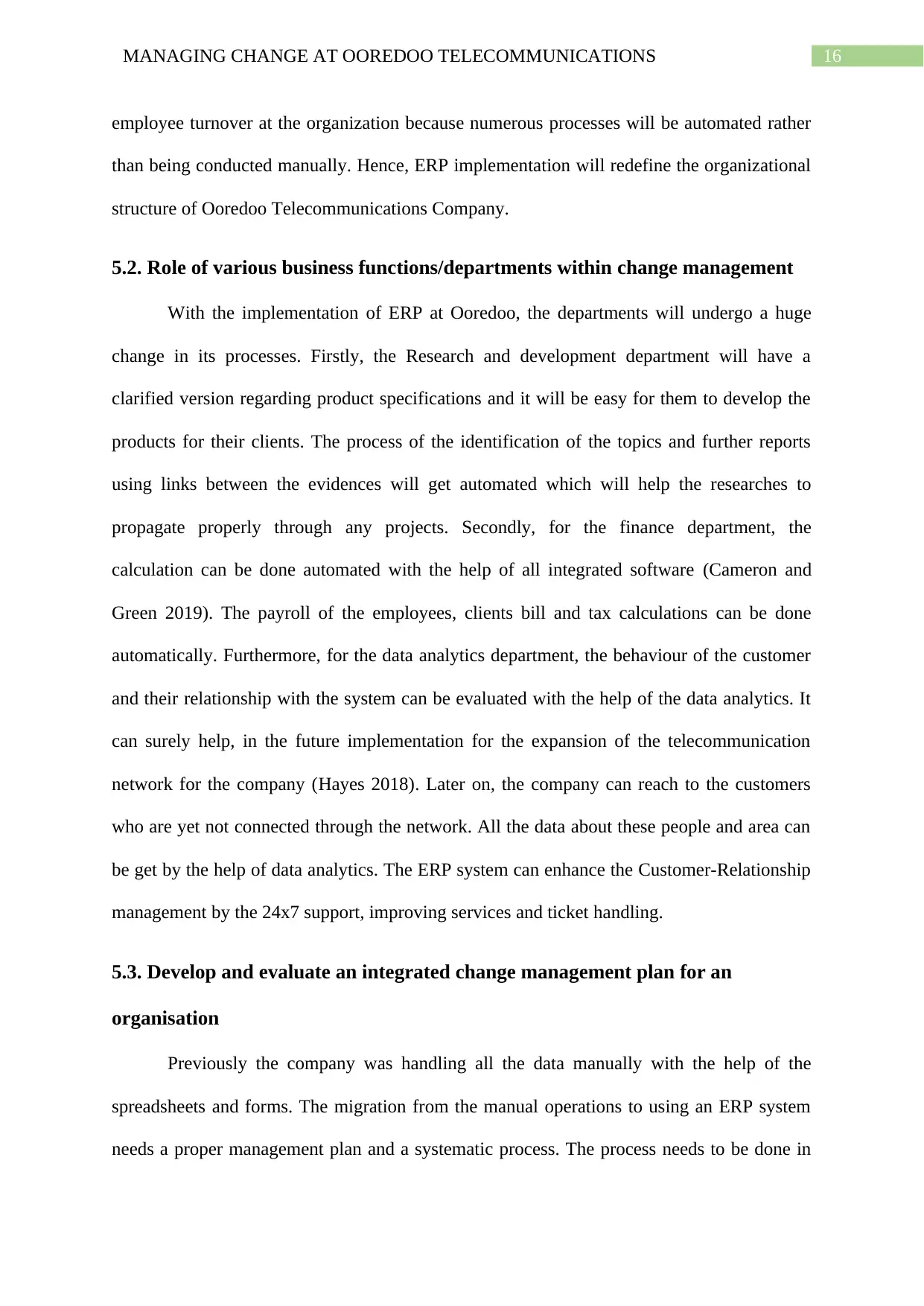
16MANAGING CHANGE AT OOREDOO TELECOMMUNICATIONS
employee turnover at the organization because numerous processes will be automated rather
than being conducted manually. Hence, ERP implementation will redefine the organizational
structure of Ooredoo Telecommunications Company.
5.2. Role of various business functions/departments within change management
With the implementation of ERP at Ooredoo, the departments will undergo a huge
change in its processes. Firstly, the Research and development department will have a
clarified version regarding product specifications and it will be easy for them to develop the
products for their clients. The process of the identification of the topics and further reports
using links between the evidences will get automated which will help the researches to
propagate properly through any projects. Secondly, for the finance department, the
calculation can be done automated with the help of all integrated software (Cameron and
Green 2019). The payroll of the employees, clients bill and tax calculations can be done
automatically. Furthermore, for the data analytics department, the behaviour of the customer
and their relationship with the system can be evaluated with the help of the data analytics. It
can surely help, in the future implementation for the expansion of the telecommunication
network for the company (Hayes 2018). Later on, the company can reach to the customers
who are yet not connected through the network. All the data about these people and area can
be get by the help of data analytics. The ERP system can enhance the Customer-Relationship
management by the 24x7 support, improving services and ticket handling.
5.3. Develop and evaluate an integrated change management plan for an
organisation
Previously the company was handling all the data manually with the help of the
spreadsheets and forms. The migration from the manual operations to using an ERP system
needs a proper management plan and a systematic process. The process needs to be done in
employee turnover at the organization because numerous processes will be automated rather
than being conducted manually. Hence, ERP implementation will redefine the organizational
structure of Ooredoo Telecommunications Company.
5.2. Role of various business functions/departments within change management
With the implementation of ERP at Ooredoo, the departments will undergo a huge
change in its processes. Firstly, the Research and development department will have a
clarified version regarding product specifications and it will be easy for them to develop the
products for their clients. The process of the identification of the topics and further reports
using links between the evidences will get automated which will help the researches to
propagate properly through any projects. Secondly, for the finance department, the
calculation can be done automated with the help of all integrated software (Cameron and
Green 2019). The payroll of the employees, clients bill and tax calculations can be done
automatically. Furthermore, for the data analytics department, the behaviour of the customer
and their relationship with the system can be evaluated with the help of the data analytics. It
can surely help, in the future implementation for the expansion of the telecommunication
network for the company (Hayes 2018). Later on, the company can reach to the customers
who are yet not connected through the network. All the data about these people and area can
be get by the help of data analytics. The ERP system can enhance the Customer-Relationship
management by the 24x7 support, improving services and ticket handling.
5.3. Develop and evaluate an integrated change management plan for an
organisation
Previously the company was handling all the data manually with the help of the
spreadsheets and forms. The migration from the manual operations to using an ERP system
needs a proper management plan and a systematic process. The process needs to be done in
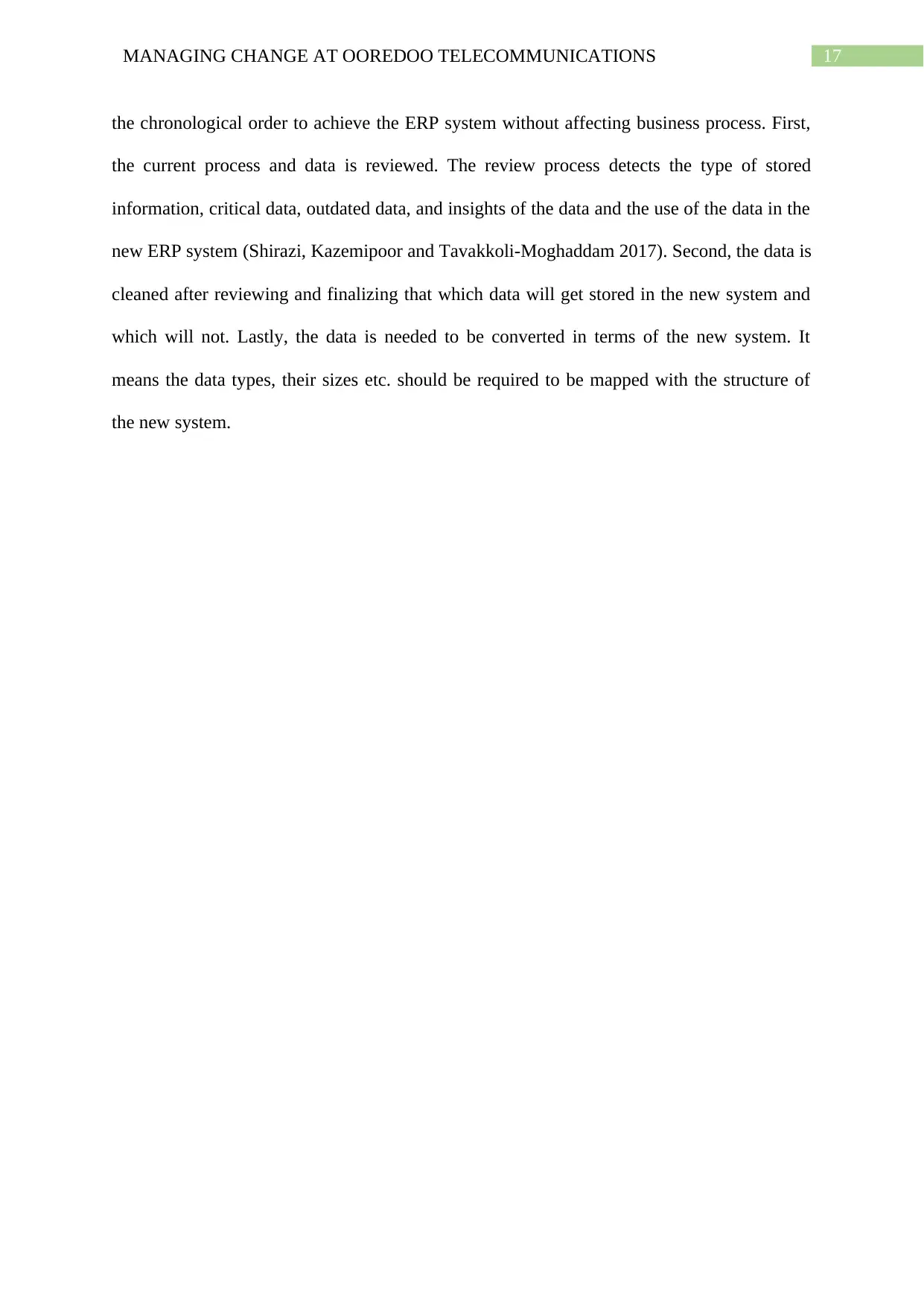
17MANAGING CHANGE AT OOREDOO TELECOMMUNICATIONS
the chronological order to achieve the ERP system without affecting business process. First,
the current process and data is reviewed. The review process detects the type of stored
information, critical data, outdated data, and insights of the data and the use of the data in the
new ERP system (Shirazi, Kazemipoor and Tavakkoli-Moghaddam 2017). Second, the data is
cleaned after reviewing and finalizing that which data will get stored in the new system and
which will not. Lastly, the data is needed to be converted in terms of the new system. It
means the data types, their sizes etc. should be required to be mapped with the structure of
the new system.
the chronological order to achieve the ERP system without affecting business process. First,
the current process and data is reviewed. The review process detects the type of stored
information, critical data, outdated data, and insights of the data and the use of the data in the
new ERP system (Shirazi, Kazemipoor and Tavakkoli-Moghaddam 2017). Second, the data is
cleaned after reviewing and finalizing that which data will get stored in the new system and
which will not. Lastly, the data is needed to be converted in terms of the new system. It
means the data types, their sizes etc. should be required to be mapped with the structure of
the new system.
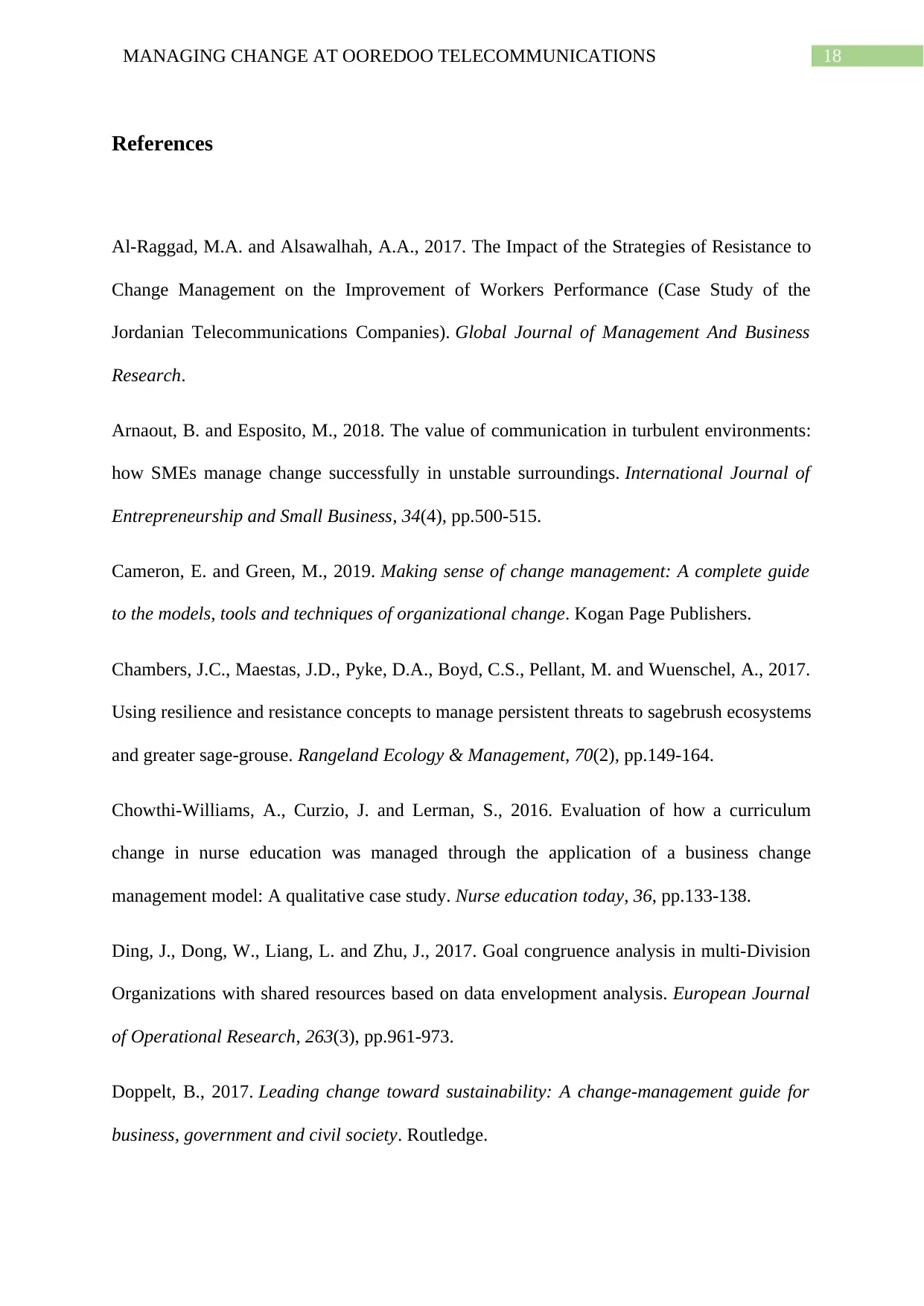
18MANAGING CHANGE AT OOREDOO TELECOMMUNICATIONS
References
Al-Raggad, M.A. and Alsawalhah, A.A., 2017. The Impact of the Strategies of Resistance to
Change Management on the Improvement of Workers Performance (Case Study of the
Jordanian Telecommunications Companies). Global Journal of Management And Business
Research.
Arnaout, B. and Esposito, M., 2018. The value of communication in turbulent environments:
how SMEs manage change successfully in unstable surroundings. International Journal of
Entrepreneurship and Small Business, 34(4), pp.500-515.
Cameron, E. and Green, M., 2019. Making sense of change management: A complete guide
to the models, tools and techniques of organizational change. Kogan Page Publishers.
Chambers, J.C., Maestas, J.D., Pyke, D.A., Boyd, C.S., Pellant, M. and Wuenschel, A., 2017.
Using resilience and resistance concepts to manage persistent threats to sagebrush ecosystems
and greater sage-grouse. Rangeland Ecology & Management, 70(2), pp.149-164.
Chowthi-Williams, A., Curzio, J. and Lerman, S., 2016. Evaluation of how a curriculum
change in nurse education was managed through the application of a business change
management model: A qualitative case study. Nurse education today, 36, pp.133-138.
Ding, J., Dong, W., Liang, L. and Zhu, J., 2017. Goal congruence analysis in multi-Division
Organizations with shared resources based on data envelopment analysis. European Journal
of Operational Research, 263(3), pp.961-973.
Doppelt, B., 2017. Leading change toward sustainability: A change-management guide for
business, government and civil society. Routledge.
References
Al-Raggad, M.A. and Alsawalhah, A.A., 2017. The Impact of the Strategies of Resistance to
Change Management on the Improvement of Workers Performance (Case Study of the
Jordanian Telecommunications Companies). Global Journal of Management And Business
Research.
Arnaout, B. and Esposito, M., 2018. The value of communication in turbulent environments:
how SMEs manage change successfully in unstable surroundings. International Journal of
Entrepreneurship and Small Business, 34(4), pp.500-515.
Cameron, E. and Green, M., 2019. Making sense of change management: A complete guide
to the models, tools and techniques of organizational change. Kogan Page Publishers.
Chambers, J.C., Maestas, J.D., Pyke, D.A., Boyd, C.S., Pellant, M. and Wuenschel, A., 2017.
Using resilience and resistance concepts to manage persistent threats to sagebrush ecosystems
and greater sage-grouse. Rangeland Ecology & Management, 70(2), pp.149-164.
Chowthi-Williams, A., Curzio, J. and Lerman, S., 2016. Evaluation of how a curriculum
change in nurse education was managed through the application of a business change
management model: A qualitative case study. Nurse education today, 36, pp.133-138.
Ding, J., Dong, W., Liang, L. and Zhu, J., 2017. Goal congruence analysis in multi-Division
Organizations with shared resources based on data envelopment analysis. European Journal
of Operational Research, 263(3), pp.961-973.
Doppelt, B., 2017. Leading change toward sustainability: A change-management guide for
business, government and civil society. Routledge.
Paraphrase This Document
Need a fresh take? Get an instant paraphrase of this document with our AI Paraphraser
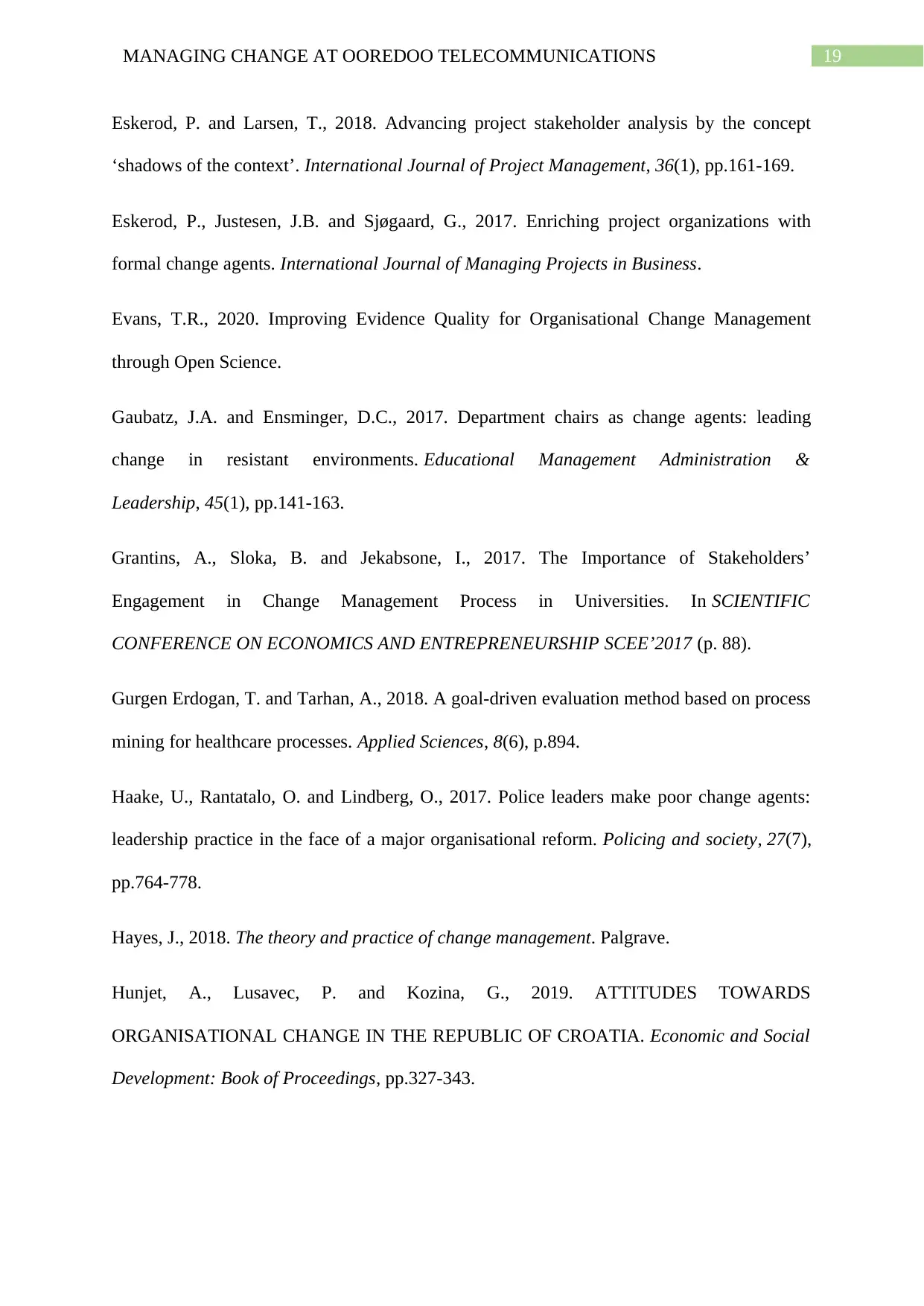
19MANAGING CHANGE AT OOREDOO TELECOMMUNICATIONS
Eskerod, P. and Larsen, T., 2018. Advancing project stakeholder analysis by the concept
‘shadows of the context’. International Journal of Project Management, 36(1), pp.161-169.
Eskerod, P., Justesen, J.B. and Sjøgaard, G., 2017. Enriching project organizations with
formal change agents. International Journal of Managing Projects in Business.
Evans, T.R., 2020. Improving Evidence Quality for Organisational Change Management
through Open Science.
Gaubatz, J.A. and Ensminger, D.C., 2017. Department chairs as change agents: leading
change in resistant environments. Educational Management Administration &
Leadership, 45(1), pp.141-163.
Grantins, A., Sloka, B. and Jekabsone, I., 2017. The Importance of Stakeholders’
Engagement in Change Management Process in Universities. In SCIENTIFIC
CONFERENCE ON ECONOMICS AND ENTREPRENEURSHIP SCEE’2017 (p. 88).
Gurgen Erdogan, T. and Tarhan, A., 2018. A goal-driven evaluation method based on process
mining for healthcare processes. Applied Sciences, 8(6), p.894.
Haake, U., Rantatalo, O. and Lindberg, O., 2017. Police leaders make poor change agents:
leadership practice in the face of a major organisational reform. Policing and society, 27(7),
pp.764-778.
Hayes, J., 2018. The theory and practice of change management. Palgrave.
Hunjet, A., Lusavec, P. and Kozina, G., 2019. ATTITUDES TOWARDS
ORGANISATIONAL CHANGE IN THE REPUBLIC OF CROATIA. Economic and Social
Development: Book of Proceedings, pp.327-343.
Eskerod, P. and Larsen, T., 2018. Advancing project stakeholder analysis by the concept
‘shadows of the context’. International Journal of Project Management, 36(1), pp.161-169.
Eskerod, P., Justesen, J.B. and Sjøgaard, G., 2017. Enriching project organizations with
formal change agents. International Journal of Managing Projects in Business.
Evans, T.R., 2020. Improving Evidence Quality for Organisational Change Management
through Open Science.
Gaubatz, J.A. and Ensminger, D.C., 2017. Department chairs as change agents: leading
change in resistant environments. Educational Management Administration &
Leadership, 45(1), pp.141-163.
Grantins, A., Sloka, B. and Jekabsone, I., 2017. The Importance of Stakeholders’
Engagement in Change Management Process in Universities. In SCIENTIFIC
CONFERENCE ON ECONOMICS AND ENTREPRENEURSHIP SCEE’2017 (p. 88).
Gurgen Erdogan, T. and Tarhan, A., 2018. A goal-driven evaluation method based on process
mining for healthcare processes. Applied Sciences, 8(6), p.894.
Haake, U., Rantatalo, O. and Lindberg, O., 2017. Police leaders make poor change agents:
leadership practice in the face of a major organisational reform. Policing and society, 27(7),
pp.764-778.
Hayes, J., 2018. The theory and practice of change management. Palgrave.
Hunjet, A., Lusavec, P. and Kozina, G., 2019. ATTITUDES TOWARDS
ORGANISATIONAL CHANGE IN THE REPUBLIC OF CROATIA. Economic and Social
Development: Book of Proceedings, pp.327-343.

20MANAGING CHANGE AT OOREDOO TELECOMMUNICATIONS
Izhar, T.A.T., Baharuddin, M.F., Mohamad, A.N., Ramli, A.A.M., Shoid, M.S.M. and
Hasnol, W.M.H.W., 2016. Using ontology for goal-based query to evaluate social media
data. Journal of Advances in Humanities and Social Sciences, 2(2), pp.108-118.
Janoskova, K. and Kral, P., 2016. Acceptance of Risk of Innovations as an Important
Assumption of Innovative Organization. In International Conference on Information,
Communication and Social Sciences (ISSGBM-ICS 2016) (Vol. 66, pp. 3-7).
Kaufman, H., 2017. The limits of organizational change. Routledge.
King, F. and Stevenson, H., 2017. Generating change from below: what role for leadership
from above?. Journal of educational administration.
Kirschenbaum, A., 2019. Chaos organization and disaster management. Routledge.
Lee, J.Y. and Day, G.S., 2019. Designing customer-centric organization structures: toward
the fluid marketing organization. In Handbook on Customer Centricity. Edward Elgar
Publishing.
Leiber, T., 2019. Organizational change and development through quality management in
higher education institutions: theory, practice, and recommendations for change agents.
In Evidence-Based Initiatives for Organizational Change and Development (pp. 316-341).
IGI Global.
Liu, F., Anumba, C.J., Jallow, A.K. and Carrillo, P., 2020. Integrated change and knowledge
management approach for energy retrofits. Journal of Architectural Engineering, 26(1),
p.04019030.
Lubasi, R. and Mwangi, J.K., 2017. Organization Preparedness to Change and Employees’
Commitment: Case of the African Development Bank in Kenya.
Izhar, T.A.T., Baharuddin, M.F., Mohamad, A.N., Ramli, A.A.M., Shoid, M.S.M. and
Hasnol, W.M.H.W., 2016. Using ontology for goal-based query to evaluate social media
data. Journal of Advances in Humanities and Social Sciences, 2(2), pp.108-118.
Janoskova, K. and Kral, P., 2016. Acceptance of Risk of Innovations as an Important
Assumption of Innovative Organization. In International Conference on Information,
Communication and Social Sciences (ISSGBM-ICS 2016) (Vol. 66, pp. 3-7).
Kaufman, H., 2017. The limits of organizational change. Routledge.
King, F. and Stevenson, H., 2017. Generating change from below: what role for leadership
from above?. Journal of educational administration.
Kirschenbaum, A., 2019. Chaos organization and disaster management. Routledge.
Lee, J.Y. and Day, G.S., 2019. Designing customer-centric organization structures: toward
the fluid marketing organization. In Handbook on Customer Centricity. Edward Elgar
Publishing.
Leiber, T., 2019. Organizational change and development through quality management in
higher education institutions: theory, practice, and recommendations for change agents.
In Evidence-Based Initiatives for Organizational Change and Development (pp. 316-341).
IGI Global.
Liu, F., Anumba, C.J., Jallow, A.K. and Carrillo, P., 2020. Integrated change and knowledge
management approach for energy retrofits. Journal of Architectural Engineering, 26(1),
p.04019030.
Lubasi, R. and Mwangi, J.K., 2017. Organization Preparedness to Change and Employees’
Commitment: Case of the African Development Bank in Kenya.
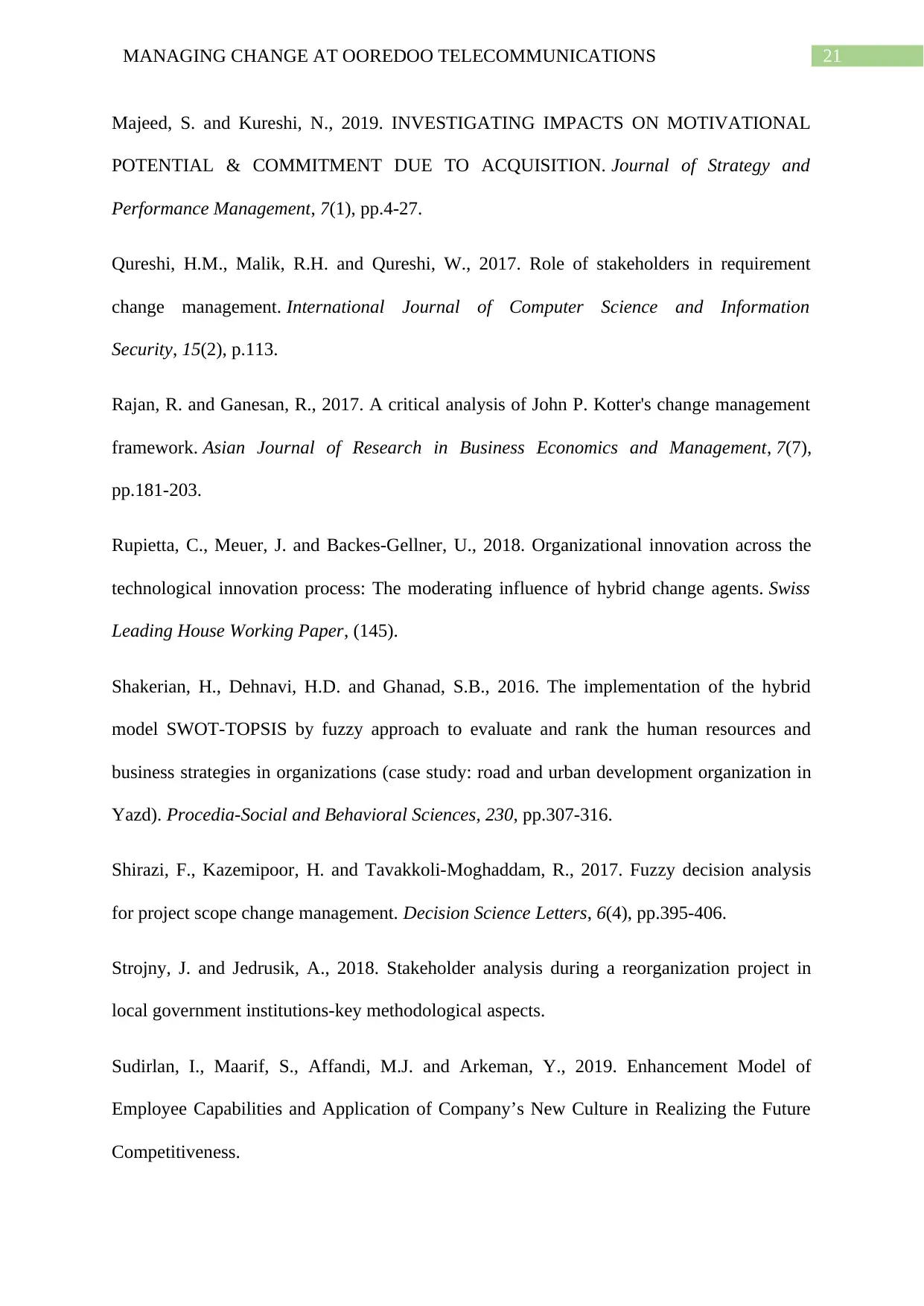
21MANAGING CHANGE AT OOREDOO TELECOMMUNICATIONS
Majeed, S. and Kureshi, N., 2019. INVESTIGATING IMPACTS ON MOTIVATIONAL
POTENTIAL & COMMITMENT DUE TO ACQUISITION. Journal of Strategy and
Performance Management, 7(1), pp.4-27.
Qureshi, H.M., Malik, R.H. and Qureshi, W., 2017. Role of stakeholders in requirement
change management. International Journal of Computer Science and Information
Security, 15(2), p.113.
Rajan, R. and Ganesan, R., 2017. A critical analysis of John P. Kotter's change management
framework. Asian Journal of Research in Business Economics and Management, 7(7),
pp.181-203.
Rupietta, C., Meuer, J. and Backes-Gellner, U., 2018. Organizational innovation across the
technological innovation process: The moderating influence of hybrid change agents. Swiss
Leading House Working Paper, (145).
Shakerian, H., Dehnavi, H.D. and Ghanad, S.B., 2016. The implementation of the hybrid
model SWOT-TOPSIS by fuzzy approach to evaluate and rank the human resources and
business strategies in organizations (case study: road and urban development organization in
Yazd). Procedia-Social and Behavioral Sciences, 230, pp.307-316.
Shirazi, F., Kazemipoor, H. and Tavakkoli-Moghaddam, R., 2017. Fuzzy decision analysis
for project scope change management. Decision Science Letters, 6(4), pp.395-406.
Strojny, J. and Jedrusik, A., 2018. Stakeholder analysis during a reorganization project in
local government institutions-key methodological aspects.
Sudirlan, I., Maarif, S., Affandi, M.J. and Arkeman, Y., 2019. Enhancement Model of
Employee Capabilities and Application of Company’s New Culture in Realizing the Future
Competitiveness.
Majeed, S. and Kureshi, N., 2019. INVESTIGATING IMPACTS ON MOTIVATIONAL
POTENTIAL & COMMITMENT DUE TO ACQUISITION. Journal of Strategy and
Performance Management, 7(1), pp.4-27.
Qureshi, H.M., Malik, R.H. and Qureshi, W., 2017. Role of stakeholders in requirement
change management. International Journal of Computer Science and Information
Security, 15(2), p.113.
Rajan, R. and Ganesan, R., 2017. A critical analysis of John P. Kotter's change management
framework. Asian Journal of Research in Business Economics and Management, 7(7),
pp.181-203.
Rupietta, C., Meuer, J. and Backes-Gellner, U., 2018. Organizational innovation across the
technological innovation process: The moderating influence of hybrid change agents. Swiss
Leading House Working Paper, (145).
Shakerian, H., Dehnavi, H.D. and Ghanad, S.B., 2016. The implementation of the hybrid
model SWOT-TOPSIS by fuzzy approach to evaluate and rank the human resources and
business strategies in organizations (case study: road and urban development organization in
Yazd). Procedia-Social and Behavioral Sciences, 230, pp.307-316.
Shirazi, F., Kazemipoor, H. and Tavakkoli-Moghaddam, R., 2017. Fuzzy decision analysis
for project scope change management. Decision Science Letters, 6(4), pp.395-406.
Strojny, J. and Jedrusik, A., 2018. Stakeholder analysis during a reorganization project in
local government institutions-key methodological aspects.
Sudirlan, I., Maarif, S., Affandi, M.J. and Arkeman, Y., 2019. Enhancement Model of
Employee Capabilities and Application of Company’s New Culture in Realizing the Future
Competitiveness.
Secure Best Marks with AI Grader
Need help grading? Try our AI Grader for instant feedback on your assignments.
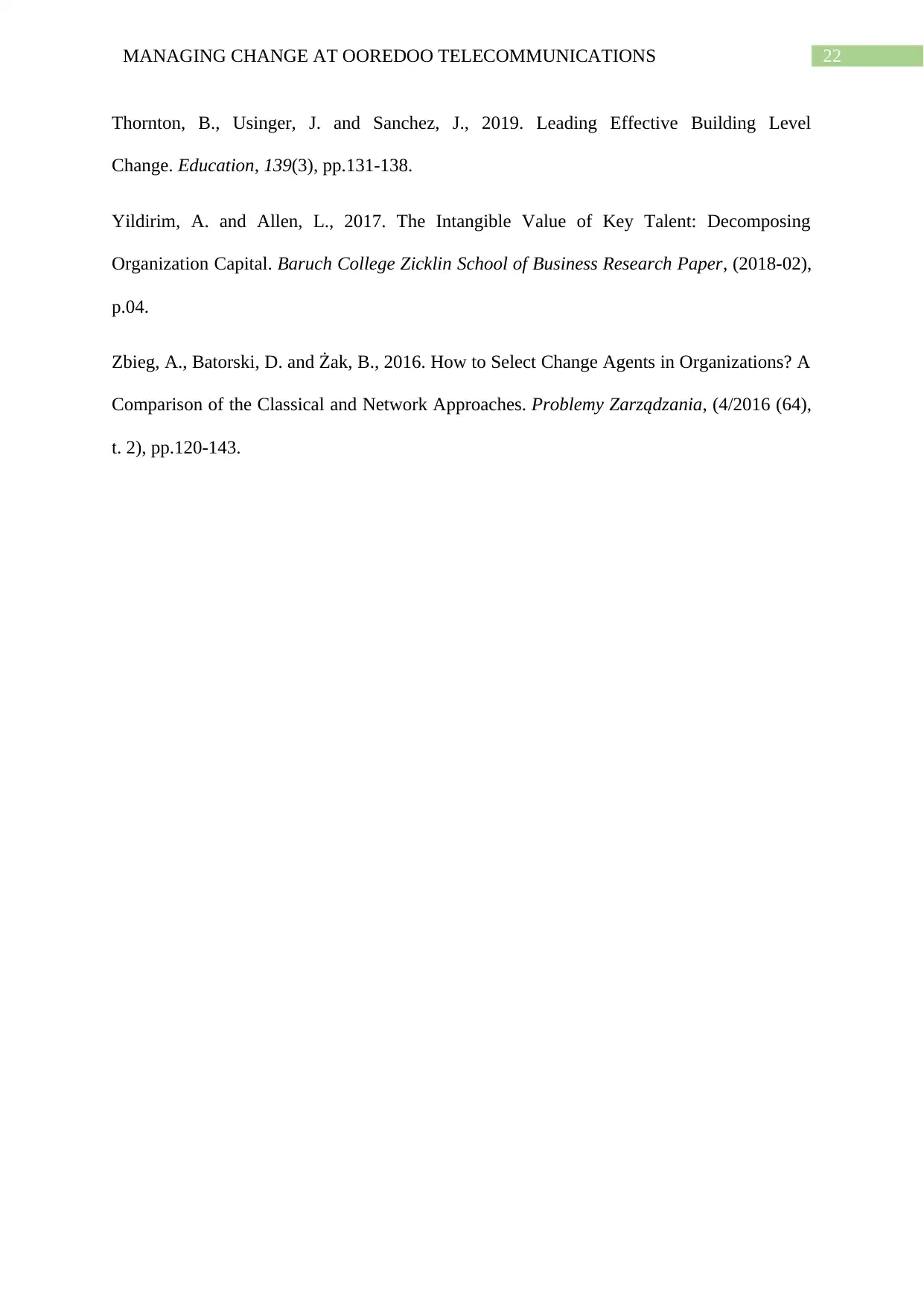
22MANAGING CHANGE AT OOREDOO TELECOMMUNICATIONS
Thornton, B., Usinger, J. and Sanchez, J., 2019. Leading Effective Building Level
Change. Education, 139(3), pp.131-138.
Yildirim, A. and Allen, L., 2017. The Intangible Value of Key Talent: Decomposing
Organization Capital. Baruch College Zicklin School of Business Research Paper, (2018-02),
p.04.
Zbieg, A., Batorski, D. and Żak, B., 2016. How to Select Change Agents in Organizations? A
Comparison of the Classical and Network Approaches. Problemy Zarządzania, (4/2016 (64),
t. 2), pp.120-143.
Thornton, B., Usinger, J. and Sanchez, J., 2019. Leading Effective Building Level
Change. Education, 139(3), pp.131-138.
Yildirim, A. and Allen, L., 2017. The Intangible Value of Key Talent: Decomposing
Organization Capital. Baruch College Zicklin School of Business Research Paper, (2018-02),
p.04.
Zbieg, A., Batorski, D. and Żak, B., 2016. How to Select Change Agents in Organizations? A
Comparison of the Classical and Network Approaches. Problemy Zarządzania, (4/2016 (64),
t. 2), pp.120-143.
1 out of 23
Related Documents
Your All-in-One AI-Powered Toolkit for Academic Success.
+13062052269
info@desklib.com
Available 24*7 on WhatsApp / Email
![[object Object]](/_next/static/media/star-bottom.7253800d.svg)
Unlock your academic potential
© 2024 | Zucol Services PVT LTD | All rights reserved.





